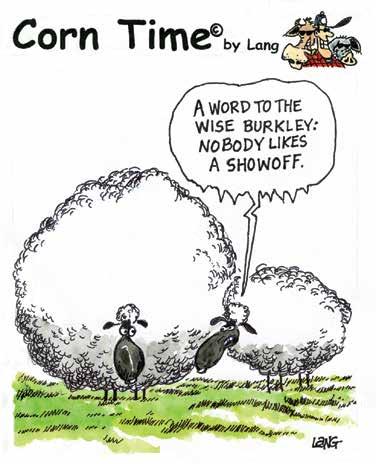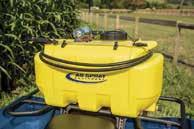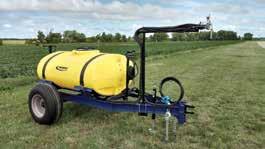

Our heritage is in protecting yours
COUNTRY Financial® was founded by a group of farmers in 1925. Our roots lie in the values born of hard work, integrity, and compassion, and we’ve been protecting farms like yours since the beginning. From cars and homes, to farm vehicles and buildings, we’ve got you covered. We know that farming isn’t a business, it’s a way of life.

















Editor-in-Chief: Samantha Carpenter Editor: Jessie Shook
Contributing Editor: Jade Randolph
Associate Editor: Mary Delph Advertising, Editorial, Subscription and Publication Offices
Somerville Road NE Decatur, AL 35601-2659
P.O. Box 2227 Decatur, AL 35609-2227 256-308-1618
AFC Officers
Rivers Myres, President
David Womack, Chairman of the Board
AFC Board of Directors
Rickey Cornutt, Brooks Hayes, Ben Haynes, Rick Hendricks, Jimmy Newby, Bill Sanders, Jeff Sims, Mike Tate
Subscription $15 per year
For subscription inquiries or change of address: P.O. Box 2227, Decatur, AL 35609-2227 or call 256-308-1623
To advertise:
Wendy McFarland 334-652-9080 or email McFarlandAdVantage@gmail.com
Cooperative Farming News is published monthly by Alabama Farmers Cooperative, Inc. 121 Somerville Road NE, Decatur, AL 35601-2659
P.O. Box 2227, Decatur, AL 35609-2227
Reproduction in whole or in part without written permission is strictly prohibited. The publisher reserves the right to refuse any advertising and will not be responsible for copy errors or misprints in advertising or editorial material, other than to publish corrections of errors in fact. Feature articles, news items and columns are published for the information of our readers from qualified, reputable sources; however, the editors and publisher make no guarantees and assume no liability for any reader’s decision to implement any procedure, recommendation or advice printed in this publication. Photos are credited to author unless otherwise noted. Advertised sale items may not be stocked by every Quality Co-op store and prices may vary.
www.alafarm.com
Postmaster:
Please send notice of address change (enclosing latest address label) to publication office: Cooperative Farming News P.O. Box 2227 Decatur, AL 35609-2227


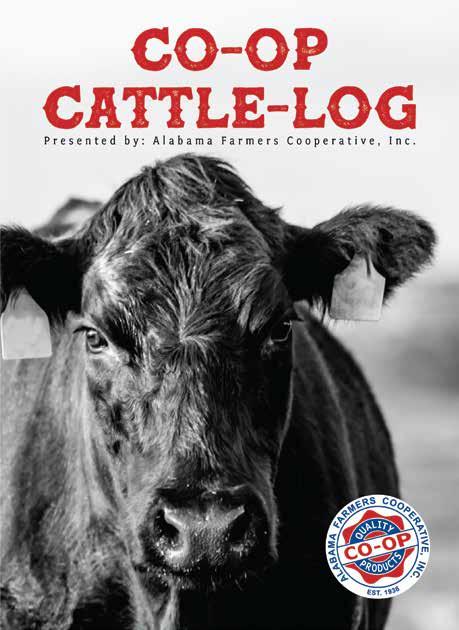
DIRECTORY OF MEMBER COOPERATIVES
ALBERTVILLE FARMERS COOPERATIVE
Branch of DeKalb Farmers Cooperative
Mark Searels, Mgr. Phone 256-878-3261
ALTHA FARMERS COOPERATIVE
Blountstown - James Lynn, Mgr. Phone 850-674-8194
ANDALUSIA FARMERS COOPERATIVE
Russell Lassiter, Mgr. Phone 334-222-1851
ATMORE TRUCKERS ASSOCIATION
Todd Booker, Mgr. Phone 251-368-2191
BLOUNT COUNTY FARMERS COOPERATIVE
Eric Sanders, Mgr. Phone 205-274-2185
CALHOUN FARMERS COOPERATIVE
Branch of Cherokee Farmers Cooperative
Jacksonville - Tommy Thomas, Mgr. Phone 256-435-3430
Piedmont - Kevin Bobbitt, Mgr. Phone 256-447-6560
CENTRAL ALABAMA FARMERS COOPERATIVE
Tim Wood, Gen. Mgr.
Selma - Thomas Reeves, Mgr. Phone 334-874-9083
Faunsdale - Bryan Monk, Mgr. Phone 334-628-2681
Demopolis - Tom Eunice, Mgr. Phone 334-289-0155
CHEROKEE FARMERS COOPERATIVE
Andrew Dempsey, Gen. Mgr.
Seth Eubanks, Mgr. / Phone 256-927-3135
CLAY COUNTY EXCHANGE
Jeff Kinder, Mgr. Phone 256-396-2097
COFFEE COUNTY FARMERS COOPERATIVE
Enterprise - Ricky Wilks, Gen. Mgr. Phone 334-347-9007
Elba - Colin Morris, Mgr. Phone 334-897-6972
COLBERT FARMERS COOPERATIVE
Daniel Waldrep, Gen. Mgr.
Leighton - Tommy Sockwell, Mgr. Phone 256-446-8328
Tuscumbia - Chuck Hellums, Mgr. Phone 256-383-6462
DEKALB FARMERS COOPERATIVE
Larry Leslie, Gen. Mgr
Rainsville - Andrea Crain, Mgr. Phone 256-638-2569
Crossville - David Tierce, Mgr. Phone 256-528-7188
ELBERTA FARMERS COOPERATIVE
William D. Carlew, Mgr. Phone 251-986-8103
ELMORE COUNTY COOPERATIVE Branch of Taleecon Farmers Cooperative
Timothy Richardson, Mgr. Phone 334-567-4321

FARMERS CO-OP OF ASHFORD
Timothy Tolar, Mgr.
Jerome Hinson, Asst. Mgr. Phone 334-899-3263
FARMERS COOPERATIVE, INC.
Todd Lawrence, Gen. Mgr.
Live Oak, FL - Barry Long, Ag Div. Mgr. Phone 386-362-1459
Madison, FL Phone 850-973-2269
FARMERS COOPERATIVE MARKET
Doug Smith, Gen. Mgr.
Frisco City - William Womack, Mgr. Phone 251-267-3175
Fertilizer / Phone 251-267-3173
Leroy - Jeff Hughston, Mgr. Phone 251-246-3512
FAYETTE FARMERS CO-OP
Branch of Marion County Cooperative Kellie Trull, Mgr. / Phone 205-932-5901
FLORALA FARMERS AND BUILDERS CO-OP Branch of Andalusia Famers Cooperative Pete Blackwell, Mgr. / Phone 334-858-6142
GENEVA COUNTY COOPERATIVE
Hartford - Todd Smith, Gen. Mgr. Phone 334-588-2992
GOSHEN FARMERS COOPERATIVE Danny Dewrell, Mgr. / Phone 334-484-3441
HEADLAND PEANUT WAREHOUSE CO-OP
Jay Jones, Mgr.
Chris Hix, Store Mgr. / Phone 334-693-3313
JACKSON FARMERS COOPERATIVE Branch of Madison County Cooperative Ramsey Prince, Mgr. Scottsboro - Phone 256-574-1688
Patricia Rorex, Mgr.
Stevenson - Phone 256-437-8829
JAY PEANUT FARMERS COOPERATIVE
Ryan Williams, Mgr. / Phone 850-675-4597
LAUDERDALE COUNTY COOPERATIVE
Reggie Shook, Gen. Mgr.
Florence - Robbie Neal, Mgr. Phone 256-764-8441
Elgin - Wendell Walker, Mgr. Phone 256-247-3453
LAWRENCE COUNTY EXCHANGE
John Holley, Gen Mgr.
Moulton - Greg McCannon, Mgr. Phone 256-974-9213
Courtland - Phone 256-637-2939
LIMESTONE FARMERS COOPERATIVE
John Curtis, Gen. Mgr. / Phone 256-232-5500
Britt Christopher, Location Mgr.
Giles County Co-op - Celena Williams, Mgr.
Lynnville, TN - Kyle Doggett, Mgr. Phone 931-527-3923
Pulaski, TN / Phone 931-363-2563
LUVERNE COOPERATIVE SERVICES
Perry Catrett, Mgr. / Phone 334-335-5082
MADISON COUNTY COOPERATIVE
Keith Griffin, Gen. Mgr.
Hazel Green - Phone 256-828-2010
Meridianville - Matt Dunbar, Mgr. Phone 256-828-5360
MARION COUNTY COOPERATIVE
Steve Lann, Gen. Mgr. Hamilton - Phone 205-921-2631
MARSHALL FARMERS COOPERATIVE
Brian Keith, Gen. Mgr. Holly Pond - Phone 256-796-5337
Arab - Adam Scott, Mgr. Phone 256-586-5515
MID-STATE FARMERS COOPERATIVE Branch of Talladega County Exchange
Columbiana - Barry Keller, Mgr. Phone 205-669-7082
MORGAN FARMERS COOPERATIVE
Lance Ezelle, Gen. Mgr.
Hartselle - Bradley Hopkins, Mgr. Phone 256-773-6832
Decatur - Trevor Johnson, Mgr. Phone 256-353-4663
New Market Ag Supply - 256-379-2553
OPP’S CO-OP
Branch of Andalusia Farmers Cooperative
Brandon Bledsoe, Mgr. Phone 334-493-7715
PIKE FARMERS COOPERATIVE
Troy - Wayne Ward, Mgr. Phone 334-566-3882
QUALITY COOPERATIVE, INC.
Greenville - Daniel Salter, Mgr. Phone 334-382-6548
RANDOLPH FARMERS COOPERATIVE
Tim Brown, Mgr. / Phone 256-357-4743
ST. CLAIR FARMERS COOPERATIVE Branch of Talladega County Exchange
Ashville - Allen Bice, Mgr. Phone 205-594-7042
Pell City - Joseph Taylor, Mgr. Phone 205-338-2821
TALEECON FARMERS COOPERATIVE
Scott Hartley, Gen. Mgr. Phone 334-257-3930
TALLADEGA COUNTY EXCHANGE
Chris Duke, Gen. Mgr.
Chris Elliott, Mgr. Phone 256-362-2716
TUSCALOOSA FARMERS COOPERATIVE
Wayne Gilliam, Mgr. / Phone 205-339-8181
WALKER FARMERS COOPERATIVE
Cody King, Mgr. / Phone 205-387-1142
WEST GENEVA COUNTY COOPERATIVE Branch of Geneva County Cooperative
Robert Pittman, Mgr. / Phone 334-898-7932
WINSTON FARMERS COOPERATIVE Branch of Marion County Cooperative
Haleyville - Jessica Steward, Mgr. Phone 205-486-3794

Quality Co-op: Specialty Products & Services
For more information, contact your local Quality Co-op
Albertville Farmers Co-op
Altha Farmers Co-op - Blountstown
Andalusia Farmers Co-op
Atmore Truckers Association
Blount County Farmers Co-op
Calhoun Farmers Co-op - Piedmont
Calhoun Farmers Co-op - Jacksonville
Central AL Farmers Co-op - Selma
Central AL Farmers Co-op - Faunsdale
Central AL Farmers Co-op - Demopolis
Cherokee Farmers Co-op
Clay County Exchange
Coffee County Farmers Co-op - Enterprise
Coffee County Farmers Co-op - Elba
Colbert Farmers Co-op - Tuscumbia
DeKalb Farmers Co-op - Rainsville
DeKalb Farmers Co-op - Crossville
Elberta Farmers Co-op
Elmore County Co-op
Farmers Co-op Inc. - Live Oak, FL
Farmers Co-op Inc. - Madison, FL
Farmers Co-op Market - Frisco City
Farmers Co-op Market - Leroy
Fayette Co-op
Florala Farmers & Builders Co-op
Goshen Farmers Co-op
Geneva County Co-op - Hartford
Headland Peanut Warehouse Co-op
Jackson Farmers Co-op - Scottsboro
Jackson Farmers Co-op - Stevenson
Jay Peanut Farmers Co-op
Lauderdale County Co-op - Florence
Lauderdale County Co-op - Elgin
Lawrence Co. Exchange - Moulton
Lawrence Co. Exchange - Courtland
Limestone Farmers Co-op
Giles County Co-op - Pulaski
Giles County Co-op - Lynnville
Luverne Cooperative Services
Madison County Co-op
Marion County Co-op
Marshall Farmers Co-op - Arab
Marshall Farmers Co-op - Holly Pond
Mid-State Farmers Co-op
Morgan Farmers Co-op - Decatur
Morgan Farmers Co-op - Hartselle
Opp’s Co-op
Pike Farmers Co-op
Quality Co-op Inc.
St. Clair Farmers Co-op - Ashville
St. Clair Farmers Co-op - Pell City
Taleecon Farmers Co-op
Talladega County Exchange
Tuscaloosa Farmers Co-op
Walker Farmers Co-op
Winston Farmers Co-op
Pea Shelling Propane Seed Drills Pecan Cracking







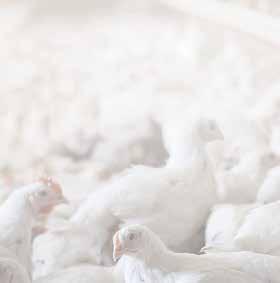






USDA joins coronavirus battle
The U.S. Department of Agriculture has joined other federal and state agencies with steps to deal with the mounting impact of the COVID-19 (coronavirus) outbreak. Among other things, the agency has announced:
• An effort with the Baylor Collaborative on Hunger and Poverty, McLane Global, PepsiCo and others to deliver nearly a million meals per week to students in a limited number of rural schools closed due to COVID-19. These boxes will contain five days’ worth of shelf-stable, nutritious, individually packaged foods that meet USDA’s summer food requirements. The use of this delivery system will help ensure rural children receive nutritious food while limiting exposure to the virus.
• Its Animal and Plant Health Inspection Service, Agricultural Marketing Service and Food Safety and Inspection Service remain committed to ensuring the health and safety of its employees while still providing the timely delivery of the services to maintain the safety of America’s food supply from the farm to the table.
• During unexpected closures, schools can leverage their participation in one of USDA’s meal programs to provide meals to students. Under normal circumstances, those meals must be served in a group setting. However, in a public health emergency, the law allows USDA the authority to waive the group setting meal requirement; that is vital during a social distancing situation.
Examining food losses at the farm, early distribution stages
It’s no secret that billions of dollars’ worth of food goes uneaten yearly throughout the world. The reasons are numerous, but the Food and Agriculture Organization of the United Nations estimates that 30% of the food loss in North America occurs at the agricultural production and harvest stages.
That finding begs the question: Why would a grower leave food in the field?
Researchers at USDA’s Economic Research Service (ERS) have identified a variety of economic factors that influence growers or distributors in their decisions regarding food loss, including:
• Price volatility;
• Labor cost and availability;
• Lack of refrigeration infrastructure;
• Aesthetic standards and consumer preferences;

An effort with the Baylor Collaborative on Hunger and Poverty, McLane Global, PepsiCo and others to deliver nearly a million meals per week to students in a limited number of rural schools closed due to COVID-19. These boxes will contain five days worth of shelf-stable, nutritious, individually packaged foods.
• Quality-based contracts; and
• Various policies related to the harvest and marketing of fresh produce.
ERS estimates that $161.6 billion of food at the retail and consumer stage of the supply chain goes uneaten yearly.
While the causes of food loss at the end stages of the supply chain have been well studied, the causes of loss on the farm and in early distribution stages have not. Food loss as it relates to fresh fruits and vegetables is especially challenging because these foods are highly perishable.
New team targets beginning farmers
USDA is launching a new team of personnel that will lead a departmentwide effort focused on serving beginning farmers and ranchers.
“More than a quarter of producers are beginning farmers,” said USDA Deputy Secretary Stephen Censky. “We need to support the next generation of agricultural producers who we will soon rely upon to grow our nation’s food and fiber.”
To formalize support for beginning farmers and ranchers and to build on prior agency work, the 2018 Farm Bill directed USDA to create a national coordinator position in the agency and state-level coordinators for four of its agencies – Farm Service Agency (FSA), Natural Resources Conservation Service (NRCS), Risk Management Agency (RMA), and Rural Development (RD).
Sarah Campbell has been selected as the national coordinator to lead USDA’s efforts. A beginning farmer herself in Maryland, Campbell held previous positions with USDA and has worked on issues impacting beginning farmers and ranchers.
In her new role, she will work closely with the state coordinators to develop goals and create plans to increase beginning farmer participation and access to programs while coordinating nationwide efforts on beginning farmers and ranchers.
“We know starting a new farm business is extremely challenging, and we know our customers value and benefit from being able to work directly with our field employees, especially beginning farmers,” Campbell said. “These new coordinators will be a key resource
“More than a quarter of producers are beginning farmers,” said USDA Deputy Secretary Stephen Censky. “We need to support the next generation of agricultural producers who we will soon rely upon to grow our nation’s food and fiber.”
at the local level and will help beginning farmers get the support they need. I look forward to working with them.”
Each state coordinator will receive training and develop beginning farmer outreach plans tailored to their state. Coordinators will help field employees better reach and serve beginning farmers and ranchers and will also be available to assist beginning farmers who need help navigating the variety of resources USDA has to offer.
To learn more about USDA’s resources for beginning farmers, as well as more information on the national and state-level coordinators, visit newfarmers. usda.gov and farmers.gov.
What happens to land that exits CRP?
A study by USDA’s Economic Research Service shows most land that exits the Conservation Reserve Program (CRP) has been put into some type of crop production.
Administered by USDA’s Farm Service Agency, CRP is the largest land retirement program in the nation. Under the CRP, landowners voluntarily retire environmentally sensitive cropland for 10 to 15 years in exchange for an annual rental payment.
Once a CRP contract expires, land may be offered for re-enrollment, subject to the availability of signup opportunities. And the acreage enrollment cap allotted to the program did in fact decline between 2007

and 2016, reducing re-enrollment opportunities by 13 million acres.
To answer the question of what happens to CRP land when a contract ends, ERS studied the fate (as of 2017) of 7.6 million acres of expiring CRP land between 2013 and 2016. That acreage amounted to approximately one-quarter of all CRP acres enrolled at the end of fiscal year 2012.
Overall, about 36% of expiring CRP land (2.8 million acres) was re-enrolled in the program. Of the 4.9 million acres that exited the program (i.e., were not re-enrolled), about 81% were put into some type of crop production — with the remainder going into grass, tree and other nonagricultural covers.
Trade policy differences continue
While the coronavirus pandemic has pushed the U.S.-China trade dispute out of the spotlight, differing views on what is, or is not, happening, continue to prevail.
On one hand, USDA officials have touted that China has taken numerous actions to begin implementing its agriculture-related commitments under the U.S.-China Phase One Economic and Trade Agreement on schedule. The agreement took effect in mid-February. These actions include:
• Signing a protocol that allows the importation of U.S. fresh chipping potatoes;
• Lifting the ban on imports of U.S. poultry and poultry products, including pet food containingpoultry products;
• Lifting restrictions on imports of U.S. pet food containing ruminant material;
• Updating lists of facilities approved for exporting to China;
• Updating the lists of products that can be exported to China as feed additives; and
• Updating an approved list of U.S. seafood species that can be exported to China.
In addition, USDA says China has begun announcing tariff exclusions for imports of U.S. agricultural products subject to its retaliatory tariffs and has announced a reduction in retaliatory tariff rates on certain U.S. agricultural goods.
Officials say these actions will facilitate China’s progress toward meeting its Phase One purchase commitments
Meanwhile, Minnesota wheat and soybean farmer Tim Dufault summed up his reaction to the Trump administration’s trade war with China at a recent House Ways and Means Committee hearing.
“We are now … two years into a trade war that we were told would be good and easy to win,” Dufault testified.
USDA says China has begun announcing tariff exclusions for imports of U.S. agricultural products subject to its retaliatory tariffs ...
“Time and again, we have been told to hold out for a deal that would make all the pain worth it. And while you would be hard-pressed to find a farmer who would disagree with the fact that China has been a bad actor, farmers have shouldered the pain for a strategy that has seen only one minor tariff reduction and several tariff escalations.”
Dufault, who represented the group Farmers for Free Trade as well as himself, was among several speakers assessing the effect of the trade war and the first phase of a new trade agreement that calls for China to buy $80 billion more in U.S. agricultural products over two years.
“The purchases, which have not yet materialized, are a promise while the tariffs are real,” Dufault said, stressing the rising number of farm bankruptcies in Minnesota and several other states. “The ag economy doesn’t live on promises. Until China buys, we are not buying the promise.”

BUSINESS OF FARMING The Farm Economy of 2020
BY JESSICA KELTON

I have a daughter whom I am extremely proud of who is attending the same great university that I did several years ago. She is intelligent, driven and will ultimately be successful. However, she’s like a lot of her peers, and truthfully like a lot of my peers, removed from the farm and relying on information that is found out in cyberspace and is usually filled with catch phrases such as sustainable, green, environmentally friendly, factory farm, and humanely raised or processed. She recently told me that she only consumed meat that was humanely raised, which I found interesting. I think the strength of the great American farmer is that they have been attempting sustainability, striving to ensure the survivability of the environment while making a living, and being sensitive to animal welfare issues long before most folks had the time, energy or money to care about that in their everyday life. Animal welfare and animal rights are not the same thing, and if some have moral issues with
animal agriculture, I think we can all agree to acknowledge those and be sensitive to those. However, it is also the right of every American consumer to make their own choices about what they believe the American farmer is and what they are consuming. I think sometimes we just need to step back and look at the real situation and address what is actually happening.
Let’s use beef as an example since it seems to be under attack by every fast food restaurant with a veggie burger. Nothing wrong with veggie burgers, and if that’s what you like then by all means have all you want (including mine) … but if you are eating it because you think beef came from a factory farm or was mistreated by some large corporate meanie that will statistically be wrong. National Agricultural Statistics Service (NASS) data shows there are 94.4 million head of cattle and calves (beef and dairy) in the U.S. as of Jan. 1, 2020. Now, before you “freak out” about how many ruminating animals are speeding us
toward certain doom (dates dependent upon agenda), take a moment to consider it in context. We actually have far fewer head of cattle than we had 50 years ago and produce more beef by far than we did then. This is a product of improved genetics, improved forage production utilization and improved management.

We should also consider where our beef cattle are located. Where are they? Certainly, we always think about Texas being the home of the cattle industry (and it is indeed the largest cattle producing state), but there are cattle producers all over the country. In fact, many of the feeder calves in feed lots out in the Midwest came from farms here in the Southeast. The majority of the lives of those cattle will be spent on farms scattered here and there and owned and managed by everyday folks who just love the agricultural lifestyle.

shows 22,046 cattle farms in the state of Alabama; of those, 18,663 have less than 100 head of cattle on their farm and nearly 15,000 have less than 50. So, that’s a pretty small number per farm for a factory farm and one would also assume that the factory farm located down the little dirt road owned by your neighbor who has a day job and then comes home and works at his farm on his off-time must be making huge amounts of profit.
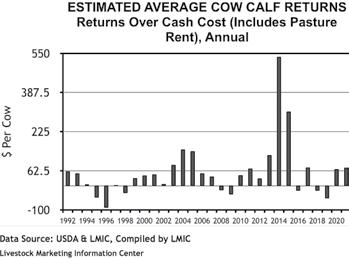
Well, for the past 20 years good producers nationally have been lucky to net $100 per animal. In fact, outside of 2014 and 2015 (which were record years) it becomes obvious that most of the cattle producers are in the cattle industry because of a love of what they do and not because of a love of money (which is not normally associated with the factory farms that are supposedly supplying all of our beef).
Consider too the size of those farms … those huge factory farms. The 2017 NASS Census of Agriculture
Are there issues in the industry? Sure. There are issues in every industry. Are there rogue producers who are just not good people? Sure. There are bad people in all industries. However, those are the exceptions and not the rule. That burger you had or that steak probably didn’t come from a huge cattle farm; chances are it came from just down the road. The beef industry like all other industries has had to adjust and improve in order to survive. There are constant advances in animal welfare and husbandry that improve the process and the product. The beauty of our country is that we have the right to make a choice as to what we consume, and I hope we always have that right. If you want to not eat that burger because you don’t like it, you are cutting back, or you have some legitimate health issues that prohibit it, that is perfectly fine, but research where your beef comes from and I think you will find it isn’t always what you read on the internet.

FEEDING FACTS
BY JIMMY PARKER

Just Chicken Feed?
Spring has come and is about finished; hopefully all of you who wanted to start a chicken project have that well underway. Even if you have not started there is still plenty of time to find and buy some baby chicks or even some hatching eggs if you have access to an incubator and know how to use it. Either way, whether you have chicks at any stage of production or you are just getting ready to get them in, they will need some feed and those needs change as the chicks grow and mature and is very dependent on what you plan to do with them.
When chicks are hatched, they come equipped with all the nutrients they need for a couple of days. The baby chicks absorb what is left of the egg yolk before
hatching and that keeps them going until they figure out where the feed and water are located. This does not mean that they don’t need to eat, because they will eventually starve if they don’t have access to feed, but water is the most crucial nutrient for the first day or two. Chickens of any age that don’t have access to water will not eat, so water is critical at all stages of production. By day two or three their nutrient reserves are playing out and they need a good high-energy, high-protein feed that contains a wide array of necessary nutrients.
Getting the baby chicks off to a good start will influence their production for their entire life. A high-energy feed with a balanced amino acid profile and ad-
equate protein in general is essential. A wide range of vitamins and minerals will also play a major role in both short-term and long-term health and productivity. Birds that are being raised to lay eggs need an 18% or higher protein feed that is balanced with enough energy to drive consumption. They don’t need a high calcium layer feed at this time and choosing to feed the wrong feed for the first few weeks will most likely cause health problems later on. The small chicks will only eat a couple of pounds of feed during the first two to three weeks and this is where meeting their needs is most critical.
Baby broiler-type chicks are genetically selected to grow faster and more efficiently than the egg-layer types or dual-purpose chicks and while an 18% protein is probably enough for the layer-type birds, the broiler chicks will need a higher protein, more nutrient-dense feed to meet their genetic potential for growth. These growth machines will function better with a well-designed feed that has 20-24% protein, high energy and a highly fortified vitamin and mineral package. As fast as the broiler chicks grow, particular attention has to be paid to the vitamins and minerals or they will have structural problems and never meet their potential.
Juvenile breeder and layer birds still need a high-quality feed and most of the starter/grower type feeds will be good enough to grow them at a healthy pace. These birds need to be fed in a manner that grows them without getting them fat and provides what they need in vitamins and minerals. Monitoring feed intake during their “teen” weeks (weeks six or seven up to 18 to 20 when laying begins) will pay dividends throughout their adult lives. Heavy fat deposits will restrict reproductive development and lifetime egg production and too much calcium can damage their system in a number of ways. These birds will
need a good quality feed, but won’t likely need more than two to three ounces per bird per day, or about a pound per bird per week.
When egg laying starts, there are a few changes that need to be made and you should switch to a layer-type feed that is higher in calcium. There are other factors to consider. In hot weather, a higher protein feed will help the hens lay more eggs. They will eat less feed and need less calories, so the concentration of protein and amino acids needs to be higher. In cold weather, they will need more total feed and the protein percentages can be lower. Many hens will cut back or even stop laying in the colder months and that too will lead to a lower need for protein. As a general rule of thumb, hens need about one ounce of a good feed per pound of body weight per day. They will need a bit more in cold weather and a bit less during the hotter times of year. That should be somewhere between four and seven ounces per hen per day or around two pounds per hen per week unless you have a really heavy breed.
Treats are another topic that often comes up when discussing backyard-type chickens. It is always fun to scatter some scratch grains in front of your birds and watch them run and scratch and pick up the food. This is a healthy thing and the raking and scratching action is one that is very natural to these birds. One thing to keep in mind is that scratch grains and other “treats” are not complete feeds and do not need to be fed as such. A good rule of thumb is that no more than 10% of the diet should be treats and as the level of treats increase, the level of protein needs to be increased accordingly. For example, if a hen eats a half ounce of scratch grains (lower protein) she will eat a half ounce less of her complete (higher protein) feed so it will need to be a bit more concentrated (18 instead of 16 or 22 instead of 18%) to make up that difference.


As fast as the broiler chicks grow, particular attention has to be paid to the vitamins and minerals or they will have structural problems and never meet their potential.
BY JOHN SIMS

It’s calf feeding time again! Time to wean and precondition your calves to maximize your gain and profit. In addition to your vaccination protocol, the feed you select to grow your cattle is of the greatest importance. There are many types of feed available, but only one that delivers proven, consistent weight gain and feed efficiency that outperforms commodities. CPC Grower 13R combines convenience, performance and profitability in the premier calf feeding program in Alabama.
CPC GROWER 13R is a bulk textured feed designed to be fed in a free choice feeder to growing calves from the creep stage (250 lbs) through the preconditioning stage (750 lbs).
• Feed at a rate of 1.1 to 2.9 pounds per 100 lbs of body weight per day.
• 13% protein, 3.5% fat, 24% fiber.
• This feed contains steam flaked corn to maximize the digestible energy.
• There is effective fiber, to slow down the nutrient passage rate in the rumen and maximize feed efficiency.
CPC GROWER 13R
• The correct protein to energy ratio assures your calves will meet their genetic potential for frame and muscle without getting too fleshy.
• The complete vitamin/mineral package ensures animal health, efficient nutrient utilization and better overall animal performance. Key trace minerals are chelated for better absorption.
• Rumensin is added for increased weight gain, improved feed efficiency and to aid in prevention of coccidiosis.
There are many copycat feeds on the market, but only one CPC GROWER 13R that has years of field testing and proven performance on thousands of Alabama calves.
For pricing and availability, call your local Quality Coop store. If you need more product information, call your local Regional Feed Specialist:
BY BAXTER BLACK, DVM

The Vet Wife’s Refrigerator
A scream from the kitchen. The thud of a faint. She sighs and arises and walks with restraint. Her neighbor lays peaceful, eyes fixed in a stare She’s passed out in front of the new Frigidaire.
She looks at the rack with eggs in its keep Winking up at her is the eye of a sheep. There’s a bottle of PenStrep near the Swanson’s Pot Pies And down in the crisper’s a bagful of flies.
The butter tray’s filled with test tubes of blood Marked, “E.I.A. samples, from Tucker’s old stud.”
High on the shelf near a platter of cheese Is a knotted, but leaking, obscene plastic sleeve.
Fecal containers are stacked, side by side, With yesterday’s piece of chicken, home fried. The freezer’s a dither of guts, lungs and spleens Scattered amongst the Birds Eye green beans.
Her home’s a museum of animal parts.
Lymphomatous lymph nodes, selenium hearts. Enough tissue samples to hold up a bridge But why do they always end up in the fridge?
But she doesn’t worry or turn up her nose, She’s the wife of a vet, it’s the life that she chose.
But maybe he’d worry at lunch if he knew He might just be dining on Whirl-Pack stew!
Equine Virology 101
BY DR. TONY FRAZIER

Dr. Larry Swango taught me and a few thousand other veterinary students virology. And while I can’t speak for everyone else, I thought virology was a little difficult. That’s not because Dr. Swango didn’t do an excellent job of teaching us. It’s just that to be so small, viruses are very complicated entities. So, while I may not exactly be able to tell you the role of reverse transcriptase in replicating the genomes of retroviruses, I did leave veterinary school with a good working knowledge of virology. So, my goal today is to give you a general understanding about virology so that you will feel obliged to vaccinate your horses against equine encephalitis and West Nile virus.
A virus is an organism that requires a host cell to replicate or reproduce itself. A Medicine News Today website states that viruses are considered to be the most abundant biological entity on the planet. In a very
elementary way of looking at it, a virus is a piece of RNA or DNA that lives in some kind of package. Now some of the packages have different bells and whistles on them that allow them to attach to the host cell and gain access. Once the virus gains access to the host cell, the RNA or DNA gets access to the nucleus or control center of the cell and begins to replicate itself. It is not that much different from some of the old superhero or other movies when the bad guys get control of some nuclear missile control center (the cell nucleus) and turn the missile on the United States (the host cell or the host such as the horse for our purposes today.) The only problem is that with viruses there is generally no superhero who is going to come in and save the day after the virus has established itself. However, there are times in these movies that the CIA or special forces (the immune system) intercepts the bad
guys before they can take charge of the controls and the threat is neutralized.
While there are some antimicrobial agents, such as Tamiflu, that work against some viruses, for the most part treatments for viral illnesses are limited to supportive care. So, we treat the dehydration that results from the diarrhea caused by a canine parvovirus infection while the virus “runs its course.” Depending on how virulent the virus is, sometimes the supportive therapy wins. Sometimes the virus wins. Just be aware that we are generally not treating with antiviral drugs but are trying to stay ahead of the damage caused by the virus with supportive care.
Another interesting thing about viruses is that they generally prefer specific types of tissues in the host. The influenza virus usually prefers respiratory tissue. The same applies to the common cold. The difference in the two viruses that affect the respiratory system is the degree of virulence.
The Eastern encephalitis virus, West Nile virus (another encephalitis virus that affects the brain) and rabies all prefer nervous tissues. For some reason the prognosis for neurological viruses is generally more pessimistic than most of those that attack other tissues. The recovery rate in horses for those viruses I just mentioned is more optimistic for the West Nile virus than for the other two. In fact, if your horse contracts Eastern equine encephalitis, it is probably going to die. If it contracts rabies, it is going to die.
vaccinated and is bitten by a mosquito incubating the West Nile virus or the Eastern equine encephalitis virus, it has a 40% and 70% chance respectively of dying, even with aggressive supportive care. The 40 percent and 70 percent are the case fatality rates (rounded off to the nearest 10 percent) for these viruses. The case fatality rate is the percent of patients that die divided by the number that are confirmed with the illness.
As I write this article, people are clearing the shelves at Walmart of disinfectant wipes, hand sanitizer and for some reason toilet paper because they are concerned about coronavirus, which has a case fatality rate of about 3 percent. That number continues to change as more cases are reported. It is interesting to me that people get so excited about a virus with a small case fatality rate, yet many horse owners do not even vaccinate against viruses that are likely to kill their horse.
If your horse is not vaccinated and is bitten by a mosquito incubating the West Nile virus or the Eastern equine encephalitis virus, it has a 40% and 70% chance respectively of dying, even with aggressive supportive care.

I want to focus on the two encephalitis viruses I just mentioned. Both Eastern encephalitis virus and West Nile virus are carried by mosquitos. Maybe if you are reading this and live in Southwest Texas, you cannot relate, but here in Alabama, we have had a mild, wet winter. In fact, they are saying that it has been the wettest winter in parts of Alabama on record. You won’t get any argument from me on that subject. Anyway, I think we generally see a huge crop of mosquitoes following a winter like this. Therefore, we have more insects available to carry those viruses. And if your horse is not
As we hear that one of the best ways to prevent the corona virus is to wash your hands, that doesn’t work for mosquito viruses – not that a horse has that option anyway. We are fortunate to have vaccines developed for these viruses in our horses because the other option for prevention is to avoid getting bitten by mosquitos. In fact, because there is no vaccine for these viruses in humans, avoiding mosquito bites and being lucky are our only two options. Playing the odds and being lucky has worked out for me so far. But I am aware of people who have died or have suffered severe brain damage because they were bitten by a mosquito carrying one of these viruses. And to be honest, avoiding mosquito bites has not worked all that well for me.
I just want to emphasize that we as horse owners have an obligation to do what we can to keep them healthy. I consider vaccinating against diseases when a vaccine is available is as much our responsibility as seeing that they get enough feed and water. If you have not already done this, please contact your veterinarian to discuss a vaccination program that is best for your horses.

BY COREY ESPY
Future Leaders Program
The Future Leaders Program was designed to teach the next generation of leaders in the Co-op system the keys to success in the agribusiness industry and give them a solid foundation to begin their career. This is accomplished by being placed in a Co-op, attending classes and participating in AFC events. The Future Leaders spend most of their time at a Co-op location where they learn valuable skills such as product knowledge and applications of the products, customer service, finances and leadership skills. Alongside the in-store training, the Future Leaders will also participate in classroom-style courses done in conjunction with the Tennessee Farmers Cooperative Management Trainee Program. These classes teach highly useful skills such as sales, finances and merchandising. Lastly, the Future Leaders will also attend AFC events such as manager’s meetings, booking shows and the annual meeting. Through these meetings, they are able to meet and build relationships with managers and Co-op staff from across the state as well as see the behind-the-scenes workings of these AFC events. With all of this, the Future Leaders Program is designed to take approximately one year to complete. Upon completion, the Future Leaders will then move to their permanent Co-op location in which they will be plugged in and begin their career. Though the Future Leaders Program is based in the store setting, there are many different career paths that can be made within the Co-op system. Many FLP graduates have gone on to work in various AFC divisions and departments such as Advertising and Grain division.

This year, we have four Future Leaders who will be finishing their time in the program and beginning their career in the coming months.
Jason Pealor is a Sharpsburg, Georgia native who made his way to Alabama where he obtained his bachelor’s degree from Auburn in Agribusiness. During his time in Auburn, Jason got the opportunity to intern at Bow and Arrow Ranch in Sand Hills, Nebraska where he got an opportunity to see a totally different style of farming. Upon graduation, Jason came into the Future Leaders Program and has been training at the Atmore Truckers Association location under 2019 Manager of the Year, Todd Booker. Jason said this about his time with the Coop,” I love working with a group of people and customers who enjoy agriculture the way I do.” It also gave him an opportunity to see the real-world application of the business concepts that he learned in college.
Justin Potts, a Trinity, Alabama native, began his time in the Future Leaders Program after graduating from Auburn with his bachelor’s degree in Agricultural Science. Justin was no newcomer to the AFC family, though. Through high school and college, Justin worked at the Lawrence County Exchange in Moulton, as well as Talleecon Farmers Cooperative in Notasulga, Alabama. This experience was the driving factor for pursuing a career with the Co-op. He said, “I loved the relationships that I developed with the customers and helping the producers in the community and that helped me make my decision of where I wanted
“We believe the program gives the Future Leaders the opportunity to be exposed to all aspects of AFC. From working in the member stores, to the shared training with TFC, to the attending our annual meeting, this allows the Future Leaders to build on what they are seeing practically in their store training. Additionally, they get to participate in retail, agronomy, livestock and all aspects of the rural lifestyle (or agricultural lifestyle)”.
Quote from James Fudge, Vice President, Management Services
to work.” Justin has spent his time in the program at Colbert Farmers Cooperative and has recently moved to Marshall Farmers Cooperative.
Jessie Boswell grew up in Selma, Alabama where she fell in love with agriculture. This helped her when she decided to attend Auburn and pursue a bachelor’s degree in Agricultural Economics. Jessie took part in an internship on the Big Island in Hawaii following


graduation in which she worked on a fruit and vegetable farm. Jessie began her career with the Co-op shortly following her internship and has been training at the Rainsville location of DeKalb Farmers Cooperative. Through her training, Jessie said that she has learned so much during her time on the program and loves working with farmers because they are the pil-
lars of the community and influence the community in such a positive way.
Will Morgan is originally from Boaz where he gained an interest in agriculture from his grandfather’s cattle farm as well as his father being a veterinarian. While in college at Auburn, Will had an internship with Cook Foods at a hatchery in Crossville, Alabama. Upon completion of his bachelor’s degree in Agribusiness from Au-


burn, Will came into the program and has been training at Morgan Farmers Cooperative in Hartselle and Decatur. Will has learned many different aspects of agriculture that he had not had experience with before his time on the Future Leaders Program. He also said that he loves the Co-op because of the customer interaction and how there is never a dull moment with his co-workers.
Jessie Boswell
Will Morgan
Jason Pealor
Justin Potts
BY JAMIE MITCHELL

Southampton K-8 Joins the Clean Campus Program
Alabama PALS is thrilled to have Southampton K-8, a Birmingham city school, as a new member of the Clean Campus Program this year. The students at Southampton are very enthusiastic about getting their program up and running! They plan to participate in campus cleanups and all PALS contests associated with the program.
I was fortunate enough to visit with the students of Southampton K-8 recently, and we talked about developing a plan for their school to follow. Schools are encouraged to shape the program in a way that works best for their curriculum and students. The purpose of the Clean Campus Program is to create a framework for the school to set goals to accomplish throughout the year to promote a cleaner campus and community. The students at Southampton were eager to define their intentions for the year and map out a plan to get there.
Great job, Southampton K-8, on your willingness to join the program and set goals for yourselves! Would a school near you benefit from hearing about the Clean Campus Program? If so, have them give me a call or email at (334) 263-7737 or jamie@alpals.org. As always,
the Clean Campus Program is available at no cost to schools thanks to our corporate sponsors. Litter prevention truly is key to a clean and beautiful future for Alabama’s youth!

4-H EXTENSION CORNER
4-H Sand Mountain and Beyond
One of the issues facing small towns and rural communities today is that young people who grew up there are choosing to leave to find employment in other places. Convincing them to stay and stopping what some call “brain drain” has become quite a challenge for these areas.
To address this migration, six counties in Northeast Alabama (Blount, Cherokee, Cullman, DeKalb, Etowah, Jackson, Madison and Marshall) decided to work together to show young people that staying in their home areas can be a positive thing. The group, called 4-H SET 2, applied for an Innovation Grant from the Alabama 4-H Club Foundation. Their goal was to make more students aware of the rewarding and satisfying jobs and careers right in their home areas. Since so many youngsters do not know what they want to do after high school, this grant would also introduce 4-H’ers to various career opportunities available in the Sand Mountain area.
BY CAROLYN DRINKARD

The “4-H Sand Mountain and Beyond Agriculture Careers Program” offered four trips to area businesses within a day’s drive of Sand Mountain. Each trip focused on entrepreneurship, vocational training, career development and youth retainment to this area. Organizers emphasized agriculture, animal science, natural resources, science and technology, and family and consumer science to 4-H members, who had either completed project work or signed up for projects within these areas.
“Our hope was that our youth would become excited and more engaged within their individual communities,” explained Amy Burgess, County Extension Coordinator from Etowah County. “We also hoped that it would be a visual reminder to the area of all that 4-H offers its young people!”
Starting in August, the first trip focused on agriculture, taking students to Witts Nursery in Hayden, Allman’s Tomato Farm in Oneonta and the Alabama Farmers Cooperative headquarters in Decatur.
The second tour spotlighted animal agriculture with students touring Tucker Milling Plant in Guntersville, Cluck ‘N Time Poultry Farm in Cullman, the Auburn Experiment Station in Crossville and Keystone Foods in Gadsden.
The third excursion highlighted natural resources, offering visits to the Tennessee Valley Authority Aquatic
Cooper and Will Burgess of Blount County enjoy the ripe apples being harvested at Allman Farms in Blount County.
Participants hearing from Destiny Allman of Allman Farms in Blount County about tomato production.


Management Program in Guntersville, Davis Fish Farm in Piedmont, Brown Farm in Cherokee County and Murphree Seed in Collinsville.
The fourth outing explored STEM activities at Dixie Grinders in Guntersville, the McWane Science Center in Birmingham and the Northeast Alabama Regional Airport in Gadsden.
“On each trip, we wanted to show local people who were excited and enjoyed their jobs,” Burgess added.
After the 4-H’ers finished their visits, they completed surveys to see what they liked, what they learned and

how they hoped to use this in the future. Harper Beaird, a 4-H member from Etowah County, felt these experiences made her more aware of two careers she had never considered before.
“I didn’t know anything about working in a poultry plant, and I didn’t realize everything involved in the proper care of plants, but now that I understand, I think either of those occupations could be fun.”
One thing that the surveys revealed was that various jobs became more attractive as a possible future career choice when the students truly understood what went on behind the scenes in each job. Others learned things that would eventually help them in their 4-H Grows projects. For example, 4-H’ers learned the importance of plants in the ecosystem, such as pine trees and cones being used in providing electricity. Many respondents explained that they gained a better appreciation of plant care. One student pointed out that the broccoli, Brussels sprouts and cabbage plants she received in her horticulture project were still “growing well.”
Respondents also highlighted anything that surprised them. Many were unaware of the important roles that scientists and physiologists play in plant and animal agriculture. “I didn’t realize there are scientists who solely study soil and weeds,” one student stated.
The positive survey responses excited 4-H leaders, spurring them to start planning for next year, offering even more experiences for their students.
“We wanted to show our students they could combine things they love with their careers!” Burgess stated. “We wanted to showcase how you can do what you love, but stay where you grew up, right here around Sand Mountain!”
At Tucker Milling Feeds in Guntersville, an employee shows Colton Lauderdale, a Blount County 4-H member, the same feed that Colton feeds to his 4-H chick chain birds. Colton got to see some of that feed made and then smell it as it came off the line.
All of the participants on the animal agriculture tour enjoyed exploring the careers available in agriculture. These students are all from Blount, Cherokee, DeKalb, Etowah, Jackson or Madison counties.
Milky Cornutt of Marshall County and Harper Beaird of Etowah County take in the geraniums that Jimmy Whitt of Whitts Nursery in Blount County provided them.
Students test plants for NASA partnership
Originally published in the Clanton Adviser, Feb. 5, 2020
Experiments by local students are helping determine what fresh produce astronauts could grow in space.
Select students in agriculture classes at LeCroy Career Technical Center and Chilton County High School participated in collecting data on lettuce that will be given to Fairchild Tropical Botanic Garden and eventually NASA to help determine what plants will grow well in the controlled mini-greenhouse the project used. The greenhouse system is similar to one on the International Space Station.
“NASA is in the process of going back to the moon … President (Donald) Trump has kind of made it a focus to get us back to the moon with the hopes of making it back to Mars,” LCTC horticulture teacher Landon Lowery said. “The astronauts right now ... are having to eat freeze-dried foods — very little fresh foods at all … For going to Mars, that is about a three- to five-month journey, so they are needing fresh produce to give them the ability of having nutrients. Freeze-dried food loses a lot of the nutrition.”
He said NASA is also hoping to be able to add flavor to the astronauts’ diet through the fresh produce.

“The idea of sending a seed up, something that will grow really fast that they can either use on the journey to Mars or better yet once they get there and then can start growing their own food,” Lowery said.
Lowery said he and CCHS agriscience teacher Marlon Harton found out about Growing Beyond Earth program, a partnership between Fairchild and NASA, at the National FFA Convention.
“The system was designed at Fairchild, and it was set up for Title I schools to set up STEM education processes and get kids introduced to how scientific research works,” Lowery said.
The system is a miniature greenhouse that allows students to control the color and intensity of light and water intake in a 2 foot by 2 foot area. Variables are determined by Fairchild, so each of the classes are testing the same thing on the same week.
“They compile all of the school’s data and you can get an updated weekly comparison of how our plants are doing versus the average of all schools,” Lowery said. “There are about 1,000 schools across the U.S. (participating). The idea there was for NASA to do this kind of research it would take thousands upon thou-
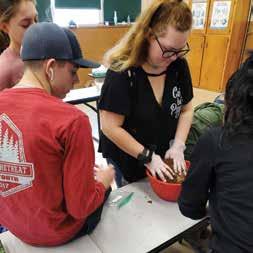

sands of dollars, whereas for schools we already have the building and the facility and all to do it, plus they are not having to pay me as the teacher and the students as the scientists. So, they are getting 1,000 replication data points in a four-week period that would take them years to get (otherwise).”
LeCroy students were working with three varieties of lettuce. The control in the experiment was Outredgeous, while the experimental varieties were Black Seeded Simpson and Flashy Trout’s Back. All of the varieties were a leaf lettuce (similar to romaine lettuce).
A specialized soil with fertilizer pellets was used to grow the plants. LCTC student Isabella Jones said the fertilizer releases slowly over the course of a month or two.
Outredgeous was used as the control in the experiment because it has been used in previous years. “We are comparing everything back to it,” Lowery said. Lowery said schools in the program were assigned different varieties.
The miniature greenhouse came to the school as a kit that students had to assemble. “We had to water it and measure it and make sure that everything was the same (for each of the six plants),” LCTC student Laderricka Duniga said.
LCTC student Kaitlyn Jones said the project focused on how large the plants could grow and how healthy they were. The project also helped the students determine how often the plants should be watered.

“We came back one day, and they were wilted, but the next day we watered them, and they were fine,” Jones said. The plants had gone about four days without being watered.
Lowery said this data will allow NASA to create a watering schedule and determine how much water needs to be sent with the team for the plants.
Data recorded during the month-long experiment included measuring the plants, amount of water given to the plants and weighing the harvested plants. Controlling humidity was a challenge.
LCTC student Dallas Day said she had been interested in how a lack of gravity in space would impact plants. “Plants when the roots grow gravity tells them which way (for) the roots to grow,” Day said.
Lowery explained that the variety of plants chosen for the experiment do not need gravity to know which direction to grow, so a lack of gravity would not have a negative impact.
Checking on the plants was the first thing Kaitlyn Jones and Duniga said as they enjoyed watching the plants grow. Isabella Jones said she enjoyed growing the plants because she wants to have a career in horticulture. Kaitlyn Jones and Duniga will also be using the data collected for their FFA Agriscience Fair project.
Further opportunities with the program include students testing their own variables and presenting the scientific research at the Kennedy Space Center. Lowery said this is something he hopes to be able to take advantage of in the future.


4: Samples were placed in the Space Growth Chamber provided to the school by NASA. The different varieties of lettuce planted show fast growth in the controlled chamber. 5: Students enjoyed measuring the plants each day to see the progress. 6: After just a month of growing and monitoring the results, students perform final measurements and weigh the crops to report results.
Busy Bee Activities
Did You Know?
Alabama is one of the country’s leading cotton producers. However, cotton only accounts for approximately 3.5% of the total farm and forestry income.
FROM WILDLIFE AND FRESHWATER FISHERIES
BY CHUCK

The Golden Eagle Project
The Nongame Wildlife Program focuses research on many fascinating critters in Alabama.
Alabama offers diverse habitats for numerous wildlife species, including the bald eagle and the golden eagle. While most people know bald eagles occur in Alabama, few are aware the state has a wintering population of golden eagles. Unlike bald eagles, golden eagles are closely related to hawks and winter in Alabama’s forested ridgelines, foraging along small forest openings abundant in their primary food source –small mammals and carrion. Due to their preference for forested landscapes, golden eagles are rarely sighted while bald eagles can often be seen soaring over open fields and water.
As its name implies, the golden eagle has a patch of bright gold on the back of its head and nape, with a black beak, dark brown body and brown feathered legs all the way down to the tops of its feet. Immature bald eagles are often misidentified as golden eagles, as they also have a black beak and dark brown head and tail, but if one pays close attention to key characteristics, it is possible to differentiate the two. Juvenile golden eagles have a solid white patch underneath each wing and the base of the tail, while juvenile bald eagles have a

spattering of white underneath the wings. An immature bald eagle will also appear to have a piebald, mocha or even cream-colored stomach as it goes through various white-belly plumages before reaching maturity, whereas golden eagles’ bodies remain dark as they age. It is also important to consider the time of year that the bird is seen. Golden eagles are only found in Alabama during the winter; bald eagles can be seen year-round.
Although very elusive, golden eagles have been a longtime occurrence in Alabama with records dating back to the early 1900s. For a period, it was believed that these individuals were a part of the western population, but in the 1930s, researchers identified a separate population of golden eagles that primarily winter and breed in eastern North America. Golden eagle sightings in Alabama have increased over the years. By 2011, 110 golden eagle sightings had been recorded from 36 different counties in Alabama. In 2012, the Alabama Wildlife and Freshwater Fisheries (WFF) Division Nongame Wildlife Program partnered with 15 other states to monitor gold-
en eagles throughout the Appalachian mountain range using game cameras baited with roadkill deer.
Since the implementation of the golden eagle project, 19 camera stations have been monitored throughout the state, and we have acquired more than 30,000 eagle photos from eight of those sites. In conjunction with the game camera surveys, 19 eagles have been captured and tagged with cellular transmitters within the state. Currently, eight transmitters are still active and three of those birds were tagged this past January.
Each year, these eagles make tremendous journeys, traveling anywhere from 1,700 to 2,200 miles from their breeding sites in Canada to their wintering sites in Alabama. In early November 2019, five of the eight eagles actively being tracked with transmitters began their long trek back down to Alabama, but it wasn’t until mid-December that one showed up on camera. The first to return to Alabama was “Coosa,” a female tagged in January 2019 at Talladega National Forest.
Many eagles will return to the areas where they were tagged, following a nearly identical migration route each year. One such bird, “Natchez,” was originally captured at Freedom Hills WMA in January 2015. Once she was released, her transmitter failed for unknown reasons. It was thought she was lost, but then Natchez returned to the camera site at Freedom Hills the very next winter. After recapturing her in February 2016 and outfitting her


with a new transmitter, valuable data is continued to be gained as she makes her trek each year from Canada to Northwest Alabama.
While Alabama’s tagging efforts have been primarily focused in the northern region of the state, the focus of this past survey season shifted to the southern part of the state. WFF biologists set up camera stations at three new locations: Fred T. Stimpson Special Opportunity Area (SOA), Portland Landing SOA and Autauga WMA. In addition to these new sites, stations were also located at Oakmulgee WMA and Freedom Hills WMA, along with a site at Talladega National Forest. A golden eagle appeared on camera at Portland Landing SOA in mid-January, which is the most southerly location we have of a golden eagle on camera throughout the seven years of surveys. Although the individual was only there for two days, it provided invaluable information to help us better understand the wintering distribution of golden eagles in the state.
Prior to the camera trapping and the telemetry project, little was known about the distribution and habitat preferences of golden eagles in Alabama. Due to these research efforts, we have discovered a larger wintering population in Alabama than was previously known and data now suggests that Alabama is an important overwintering site for golden eagles. This information will provide management implications and allow for WFF to evaluate potential impacts of development and other land use or management activities on the wintering population of golden eagles.
Funding for golden eagle research and monitoring is made possible each year through the sale of hunting and wildlife heritage licenses, the Alabama Nongame Wildlife Fund tax check-off, as well as matching federal funds through the Pittman-Robertson Act. In addition, The Birmingham Zoo provided funding for the three transmitters that were placed on birds in January 2020.
To learn more about Alabama’s eagles and our current research efforts, please visit www.outdooralabama. com!
Natchez during her first capture at Freedom Hills.
Whitetails absolutely love these grass stands, both annual and perennial NWSG. The perennials take a couple years to come to fruition, but the results can be worth it.
Planting Grass Cover for Whitetails
Vacancy…“Residents” Wanted

Many of us get into managing whitetails because we enjoy hunting them - we wanted to attract more whitetails to our property. But what happens when you build a “restaurant” (plant food plots), but don’t also erect a “motel” or “someplace nearby to stay?” Answer: typically your results won’t be what you expected or meet the possible potential of the spot. All of the “extra mouths and stomachs” that you just “invited” are going to need fawning cover, escape concealment and a place to stay. Planting grasses is a tactic that I believe can show fast, significant results.
Native warm season grasses (NWSG) will need a year to establish and maybe a couple to really begin to shine, so these stands should be thought out and planned in advance. This is one good thing about annual grasses – they are fast, inexpensive cover!
However, planting native warm season grasses (NWSG) are one of the tactics that I believe can show fast (well … a couple of years), significant and long-lasting results. Ask a property owner who has been in Conservation Reserve Program, Conservation Reserve Enhancement Program, Wildfire and Hurricane Indemnity Program, or one of the native grass restoration programs provided by the FSA or NRCS (Farm Service Agency or Natural Resources Conservation Service), how effective these perennial grass stands can be for providing cover to whitetails.
The type of cover that will work best for you will depend upon your region, topography and the type of habitat you currently have. Whitetails are very adaptable and live in many different types of habitat classifications. Timber stand improvement; planting trees, shrubs or
grasses; disking to stimulate native seed banks; and using fire can all be productive ways of creating the “edge cover” and diversity that whitetails love – and I suggest that a property manager consider all of the above.
If you’re in a heavily timbered area and have a mature stand with a closed canopy, then a chainsaw will probably produce the greatest, fastest results. If your property is located in farmland, marshland, riparian zone, rural area or new growth, then grasses (annual and/or NWSG perennials) can make a huge impact on how many deer are actually residing on your property.
Native grasses are one thing missing from many properties throughout the whitetails’ range - in the areas where native grass stands have historically grown oftentimes nowadays they are absent. Some choose to enlist the help of the NRCS or FSA and go strictly by the book. I highly recommend this - the NRCS will be a wealth of information and help. If you specifically want a “native grass restoration” this is a good idea, particularly if you have no experience. But if you simply want “housing” for your whitetails, this can be a “do-ityourself” project.
I keep mentioning “NWSG,” which are mainly perennials, but some of my favorite grasses are annuals like millets, different varieties of sorghum, Peredovik sunflower, Egyptian wheat, and sometimes corn and various annual or biannual legumes. Yes, I know these aren’t all grasses.
My favorite perennials include big bluestem, little bluestem, Indian grass, several varieties of switchgrass, Illinois bundleflower, side oats grama and several legumes. Obviously, not all of these are grasses, some are forbs and legumes. Many of the NWSG plants will grow in clumps rather than a thick mat, allowing for other plants like legumes to take root. The grasses will, in turn, love the nitrogen that the legumes produce.
I have tested different mixtures and blends over the years and have had good luck with most of them. Even blends of all annuals help promote fast, inexpensive “housing” for your herd and game birds.
The perennials, on the other hand, are NOT cheap, but a little can go a long way and can last for years. Several great blends can be found on the Nativ Nursery website (www.nativnurseries. com) along with help to understand planting them.
Good annual grass stands can be produced with many different recipes and ratios of plants, but if you want to make it easy, use some Blind Spot. It doesn’t get any easier than this. It was designed to help conceal blind locations and create screening cover. But guess what? If it will conceal a blind, it will also conceal a whitetail … very well I might add.
BioLogic’s Blind Spot will grow five to seven feet tall (or taller) in a couple of months; it’s simple to plant and can establish even during dry summer conditions. When specifically planting for whitetail cover, I like to mix some Egyptian wheat, maybe some other grain sorghum and sometimes even millet or corn. Most of these are tall, sturdy stalks that withstand the elements fairly well.
Got turkeys? After maturity, these grasses drop their seeds that upland birds and turkeys love. Whitetails also eat a lot of the seed before it drops. When it does drop, you will often get regrowth for the following year. Certain profound seed-producing annuals like millet, sorghum or Egyptian wheat may be prevalent for years. When the seed heads mature, they will release thousands of seeds, and those that aren’t consumed by your wildlife are potential new plants for your stand.
I have tried planting both annuals and perennials (NWSG) together, with mixed results. The annuals shoot up fast so I have a source of cover for my herd during the first year, and they (the annuals) sometimes seem to provide “structure” for the perennials as they develop. The annual seeds also help to evenly distribute some of the light, fluffy perennial seeds. Seed/plant choice is

Whitetails and other wildlife need escape cover, fawning and nesting concealment and structure to live within. Grasses planted for cover can create fast, effective housing and protection for your herd.

crucial for this tactic and, again, I would refer you back to the NRCS if I were spending the money on perennials.
You will want to prepare a flat, firm seedbed. These seeds can be broadcast but a drill will be more efficient, especially with the perennials. Most of these seeds will have a planting depth of a quarter inch or less. If broadcasted, make sure to use a cultipacker to ensure good seed-to-soil contact.
The ultimate would be a seeder specifically designed for NWSG plantings. Sometimes your county soil services office or local wildlife organization, such as a branch of Quality Deer Management Association or National Wild Turkey Federation may have one to rent. If using a drill, you must be careful because some cannot be calibrated to evenly disperse these sometimes fluffy, odd-shaped seeds. Getting a bag of some of these NWSG seeds is more like receiving a pillow than a bag of seed.
If your equipment is limited and you need to broadcast, you must also be cautious here because the fluffy, lightweight or odd-shaped seeds will sometimes need a “carrier,” or a way to disperse the seeds evenly. Some people use pelletized lime or fertilizer mixed with the seed to help it broadcast evenly.
Even if you plant with a seeder specifically designed for NWSG, you’ll likely still need to use “filler” or aggregate because of the different sizes and shapes of the various seeds and the seeding rates for each.
Make sure to fertilize well when you plant if you’re using annuals, because once the grasses get tall it will be difficult to fertilize a second time.
The second year (starting in the spring), fertilizer should be applied again to perennials. Often you’ll get a second regrowth from seed-drop off of the annuals. Sometimes running a disk through last year’s annual

grasses can create more thick edges and a stand that isn’t all uniform height and thickness.
Mowing can also help to create more irregular edge cover, which is great for whitetails, turkeys and other wildlife.
For NWSG stands, after the second or third year you will want to treat the stand with fire. Burning during the spring will help to remove clutter and promote new growth on your NWSG, which in turn encourages wildlife utilization. Make sure NOT to burn during fawning or when your hens are nesting. A prescribed burn should be done every two to three years. Even if you cannot burn, in my opinion, an unmaintained grass stand is better than no grass stand at all!
There are many tactics we can employ to enhance habitat for whitetails, but planting grasses can be one of the fastest producing and bestow some of the biggest payback. Not only for whitetails, many species love these grass stands. As long as you prepare properly, use sound planting procedures and maintain the crop correctly, you can realize the benefit of these “miracle grasses” and give your whitetails, turkeys and loads of other critters quick, efficient “housing.”
Still standing strong – here we see a stand of annual grasses after several months of wind, rain and snow cover.
If you’re mixing your own grass blend, think about the job you’ll want them to accomplish. The varieties in a blend for bedding may be different than mixing a blend to screen an area from view. If a visual screen is your goal, many like to mix in the annual, Egyptian wheat. It has a sturdy stalk and can grow 10 to 12 feet tall in a couple months.

Venison Scaloppine
Serves 6
Scaloppine is an elegant but simple dish to prepare. The flavor and texture of venison prepared as scaloppine can’t be matched.
Ingredients:
1½ pounds venison loin
2 cups all-purpose flour
2 teaspoons kosher salt
1 teaspoon freshly ground black pepper
3 extra large eggs
2 cups breadcrumbs, dried and seasoned
1 pound large button mushrooms, quartered
1½ cups sherry or marsala wine
4 tablespoons cold unsalted butter
3 tablespoons fresh thyme leaves
Note: Make a double batch of the fried venison; freeze one batch on sheet pans until frozen, then store it in freezer bags. When ready to use, remove from freezer and place on a baking sheet and bake at 200 degrees until warmed through. Meanwhile, prepare the sauce and serve with your favorite crusty bread.
1. Slice venison into 1-inch pieces. Pound to ¼ inch thick.
2. On a plate, mix together flour, salt, and pepper. On a second plate, beat the eggs with 1 tablespoon of water. On a third plate, add the breadcrumbs.
3. Lightly dredge venison in the flour mixture, then the eggs and lastly the breadcrumbs.
4. Heat oil and half the butter in a large cast-iron skillet or sauté pan. Cook about two minutes over medium heat on each side or until brown. Transfer pieces of venison to a cooling rack.
5. Add a little more olive oil and the mushrooms to the pan until juices have been absorbed. Add sherry to mushrooms and reduce by half. Add remaining butter to the pan and bring just to a boil. Lower the heat to medium and cook for about five more minutes.
6. Stir in the thyme leaves. Pour mushrooms and sauce over the venison and serve.

About Stacy Lyn Harris
Stacy Lyn Harris is a best-selling cookbook author, blogger, TV personality, public speaker, wife, and mother of seven children. She currently lives in Pike Road, Alabama, with her husband Scott and their children. Stacy Lyn regularly appears on cable and broadcast television as a guest chef and sustainable living expert. Her critically-acclaimed Harvest Cookbook was published in 2017 and contains many of her family’s favorite recipes, along with stories from her life growing up in the Black Belt and tips she’s learned along the way.


Big Bob Gibson Bar-B-Q
BY JESSIE SHOOK
When Robert Gibson began cooking barbecue on the weekends for his family in Decatur, he’d probably be surprised to know that 95 years later his family would still be following in his footsteps.
Robert, better known as “Big Bob Gibson,” had the idea to leave his everyday job with the L&N railroad and open a restaurant, which is now known as Big Bob Gibson Bar-B-Q.
“He made his very own hand-dug pit and when hickory-smoke pork and chicken aromas filled the air, crowds started to venture over from all over,” said Jacob Lilly, Big Bob Gibson’s Manager and fifth generation pitmaster.
Jacob and Andrew Lilly are brothers and the fifth generation to follow in their great-great-grandfather’s footsteps. Andrew said that he was always involved since an early age, even before he was old enough to work in the restaurant.
“I started working at the restaurant in high school on the potato bar, and I did pretty much every job in the restaurant and then started working the barbecue pits,” Andrew said. “After learning the ins and outs of each job and graduating college, I took on a bigger role in management and the business aspect.”
Andrew stated that the hard work that his family has put into this business makes it so important to carry on the Big Bob legacy for the next generations to come. “It’s really special to be a part of a family-owned business that has been around for five generations,”

Chris Lilly with his two sons Jacob and Andrew Lilly.
Big Bob Gibson’s is famous for their chicken and white sauce.

said Andrew. “I get to work alongside my grandfather, father and brother every day.”
According to Jacob, the employees are what makes Big Bob’s unique. The business has employees that are second and third generation pie makers and pitmasters. Some servers have worked at Big Bob’s for eight to ten years. “It’s in their blood just as much as my brother and me,” said Jacob.
Big Bob Gibson’s was established in 1925 and to this day still uses the same techniques as Big Bob, himself. “Our chicken and white sauce are unique because we still cook them on a brick-style pit with hickory wood as fuel just like Big Bob himself did,” said Jacob.
Big Bob’s serves pulled pork, smoked turkey breast, beef brisket, barbecue spareribs, barbecue chicken and smoked chicken wings daily and has four sauces that are served at the restaurant. Those sauces include their famous White Sauce, Championship Red Sauce, Habanero Red Sauce and Backyard Mustard Sauce.


Big Bob’s white sauce has been passed down from generation to generation. “It has intrigued so many people from all over the world because at first they don’t even know what to think about it,” said Jacob.
The restaurant is also known for its homemade pies that range from coconut, chocolate, lemon icebox, peanut butter and pecan. “The motto is you can’t leave without getting a slice of pie because it will always make you want to come back for more,” said Jacob. “Our pies are unique because they are made every morning starting at 5 a.m. from our pie ladies who were taught by their moms.”
Jacob stated that the day before Thanksgiving is their biggest pie day and each year, they try to break the record for most pies sold. In 2019, the two locations sold 700 pies, breaking the 2018 record by 20 pies.
Big Bob’s also participates in barbecue competitions three to four times a year. “We have been competing for 24 years,” stated Jacob. In 1996, Jacob and Andrew’s dad, Chris Lilly, decided to start doing competitions which later changed what Big Bob’s is today.
Big Bob’s participates in Kansas City Barbecue Society competitions and an independent competition known as Memphis in May, which is the largest pork competition in the nation.
Participating in competitions has grown the Big Bob name overall. Between 1996-2019 Big Bob’s won grand champion five times at the Memphis in May competition and has came in first 11 times in the Whole Shoulder category. Jacob said this led to sponsors such as Kingsford Charcoal, Yeti Coolers and Smithfield Pork.
Between the time-tested recipes, passion for barbecue and family, there is much more to come for this barbecue legacy. “For the future, who knows ... a Big Bob Gibson Bar-B-Q could possibly be opening up near you,” said Jacob. You will now be able to order Big Bob Gibson’s famous barbecue from wherever you are in the U.S. by visiting www.goldbelly.com.
Big Bob’s ribs are seasoned with their signature dry rub and slow smoked with hickory wood.
Big Bob Gibson’s homemade pies are made from scratch and baked fresh every day.
Andrew Lilly (left) and his brother Jacob Lilly (right) are fifth generation pitmasters and are now Managers at Big Bob Gibson Bar-B-Que.


BBQ Across Alabama
Boars Butt BBQ
2904 AL-195, Jasper
Phil's B-B-Q
534 South Randolph Ave., Eufaula
Marie's BBQ
1414 Almon St., He in
Bar-B-Que Place
1502 Gault Ave. South, Fort Payne
Speedy Pig
13670 U.S. 43, Russellville
Saw’s Juke Joint
115 Dunston Ave., Birmingham
Bow & Arrow
1977 E Samford Ave., Auburn
Smokey’s BBQ
8071 Hwy 72, W. Madison
Greenbriar BBQ
27028 Old Hwy 20, Madison
Bunyan’s Bar-B-Que
901 W. College St., Florence
LawLer’s Barbecue
Multiple Locations
Miss Myra’s Pit Bar-B-Q
3278 Cahaba Heights Rd., Birmingham
Johnny’s 1008 Oxmoor Rd., Homewood
Archibald’s Bar-B-Q
4215 Greensboro Ave., Tuscaloosa
Sho’Nuff BBQ
651 Alex City Shopping Center, Alex City
Big Bob Gibson Bar-B-Q
Multiple Locations
Bob Sykes Bar-B-Q 1724 9th Ave. N, Bessemer
Dreamland Bar-B-Que
5535 15th Ave. E, Tuscaloosa
Hook’s BBQ
103 Scouting Circle, Troy
Camp 31 BBQ
222 St. Joseph Ave., Brewton








































































































Carpet
Sheperds

Stephen Newton
FAIR WINDS AND FOLLOWING SEAS
BY CAROLYN DRINKARD
The idea of working on a boat had never entered Stephen Newton’s mind until a friend convinced him to apply for a job in 2003.
“I came from a family of loggers and truckers,” he laughed. “I knew how to drive a truck and handle myself in the woods, but I didn’t know anything about a towboat.”
Still, Newton was intrigued. The money was good; he was young and unmarried; and he would travel to parts of the world he had never seen. He applied, got the job and never looked back.
This is just one of the many beautiful sunsets Newton and his crew enjoy while working.


Starting first as a deckhand, Newton learned tow boating from the bottom up. After working with tank barges, hauling dangerous liquids like diesel fuel and gasoline, he got his tankerman license, so that he would be certified to handle these loads safely. He then went to maritime school (Sea School) in Bayou La Batre to earn his apprentice mate license. He still wanted to move up, so he worked on his steersman’s license under a licensed captain for five months. He then went back to school to get a radar endorsement and earn a mate pilot’s license, which limited him to working only if a captain or co-captain were on board. Five years ago, he earned his master’s license. He now has three different licenses: “Master of Towing upon Inland Waterways,” “Western Rivers” and “Great Lakes.” He can pilot up to a 500-ton vessel.
Even though newer boats rely on technology, the old tried and tested ways still work on the water. Newton had to study the navigation horn system, which captains use daily. In addition, he had to learn radar plotting, the use of lights and the Code of Federal Regulations.
Life on a towboat is very demanding. A typical day for Newton might include navigating the boat, coordinating with the office and dock where the boat is head-
ed, setting tasks for each crewman to do on the boat, keeping track of the amount of fuel on board or ordering groceries that are needed. Each day is different, and the crew has to be alert and focused at all times.
Newton works 20 days on and 10 days off. His boat runs a six-man crew, with four men on and two off. They work six-hour watch schedules, six on and six off.

Stephen Newton didn’t know anything about a towboat when he applied for a job 17 years ago. Now, he pilots a boat and loves life on the water.
Newton pilots the Captain Tom Brown, a towboat that pushes barges on the Intracoastal Waterway. His job demands that he stay alert and pay attention at all times.
Newton and his crew moved dredge equipment on barges from Mobile to New Orleans.
Even though this boat can move anything that needs to be transported on water, it usually pushes two barges filled with crude oil. Each barge is 300 ft. long x 54 ft. wide and capable of holding 30,000 barrels of crude, or 1,260,000 gallons.

“It wrecks your sleeping schedule,” he laughed, ”but you get used to it.”
Boat owners provide comfortable rooms, beds and other amenities for their workers. “The food is always good,” Newton laughed. “They feed us really well!”
Life on a towboat means working closely with other crewmen. “It’s like you have two families,” Newton stated, “one at home and one on the boat. You learn to depend on each other, just like family. You have to have each other’s backs at all times.”
Newton is now married and has three children. He and his family live in Coffeeville, Alabama. “This job’s hard on family life,” he added. “You miss out on a lot because you can’t just stop, pull over, get off and go home. We run 24 hours a day, 7 days a week.”
Currently, Newton works as a pilot with Blessey Marine in Harahan, Louisiana. Changing companies recently meant he had to start at a lower position, as pilot. “I have the same license as the captain, but not as many of the responsibilities,” he stated.
Newton pilots the “Captain Tom Brown,” a towboat that pushes barges along the Intracoastal Waterway, or ICW, an inland route along the Gulf of Mexico to Brownsville, Texas. The Captain Tom Brown is 76 ft. long x 35 ft. wide and 47 ft. high. It runs on a 2000 horsepower
engine. The towboat has a square bow, which can fit flush against the tow or load.
Even though this boat can move anything that needs to be transported on water, it usually pushes two barges filled with crude oil. Each barge is 300 ft. long x 54 ft. wide and capable of holding 30,000 barrels of

A friend took this image of storm clouds from another boat and sent it to Newton. Notice the huge shelf clouds over the towboat.
crude, or 1,260,000 gallons. The crew lashes the barges tightly together with winches to prevent losing control and damaging the hulls as they move.
Newton has made many journeys through America’s Intracoastal Waterways, running from Port St. Joe, Florida, to Victoria, Texas; from Juliet, Illinois, to Venice, Louisiana. He has run the Black Warrior River in Alabama, as far as a boat could go.
Weather plays a big role in daily life on a towboat. Even though all sailors desire “fair winds and following seas,” they must watch the weather at all times. If either the current or the wind changes, everything else can change in seconds. Through the years, Newton has weathered it all: tornadoes, hurricanes, ice storms and sweltering heat.
An avid hunter and outdoorsman, Newton has also seen his share of wildlife along the rivers. Snakes often get on the barges, and he has even dealt with an alligator. At times, when the barges are stopped alongside the bank or in a fleet, raccoons will hitch a ride. Once, a beaver got into the engine room, and the captain had

to get the State Fish and Game officers to come out and retrieve it.
Life on the boat can also be dangerous. Newton has fought fires onboard and worked to recover bodies of crewmen who had fallen overboard. He has witnessed a towboat try to make the bend in the river, only to hit the bank, scattering barges everywhere. The aftermath was chaotic and unpredictable, as the crew scrambled to recover the runaway barges and secure the loads they were carrying.
“You have a job to do, and it’s one you have to pay close attention to or somebody can get hurt,” he explained. “You have to be alert and focused at all times.”
There’s an old saying among veterans that if you wear out a pair of boots working on the river, you’ll never leave. Newton has been on these waters for 17 years, and he has never regretted the decision to take his first job.
“It takes a lot of dedication for a man to work this job,“ Newton said. “It’s not an easy life, but it’s one I love.”

One of the perks of this job is experiencing an incredible sunrise on the Intracoastal Waterway between Port Arthur, TX, and Lake Charles, LA.
Stephen (l) and Samantha Newton (r) have three children. Stephen’s work schedule means that he sometimes misses family activities, but the Newtons have adjusted and learned to cherish the times they are together.
BY LOIS TRIGG CHAPLIN
Pole Beans, A Summer Staple
Good ol’ pole beans. What more can be said about these tried-and-true Southern staples? Folks like pole beans for their superior flavor and long harvest. Favorite varieties are still Kentucky Wonder, Blue Lake, and Romano Italian. Now is the time to plant them if you haven’t already. Remember that soaking the seeds will speed their sprouting. For something different, consider the yard-long bean. These are the same beans often prepared as a stir-fry in Chinese buffet restaurants. The 1-foot or longer pods are snapped or cut into smaller lengths so they are easier to handle. Yard-long beans are particularly heat tolerant, making them a good choice to last longer into the summer. Harvesting often keeps the beans productive as long as possible. My late neighbor used to plant onions at the base of her pole beans to discourage the neighborhood rabbits.
HOW’S YOUR GARDEN SIMPLE TIMES THE CO-OP PANTRY

Showy Amaranth
A couple of years ago I was inspired by this planting at the Santa Rosa, California, historic home of the late Luther Burbank, famous plant breeder and developer of the still-popular Russet Burbank potato. So I grew two different heirloom varieties of amaranth just for fun –Aurelia’s Verde and Elena’s Rojo. A single towering plant of each kind was enough to cause everyone who saw it to ask, “What’s that?” I did not try to collect the edible grain, for it was too tiny, but various insects and bees seemed to enjoy the pollen on the flowers. I was thinking that birds might like the seed, but I did not see any birds feeding on the blossoms as the seeds developed the way they love our sunflowers. Amaranth will reseed so I will look for volunteers to appear this year. I love a garden with reseeding surprises, but since amaranth is related to the noxious pigweed, I will watch this one extra carefully. Because it is in the vegetable garden and adjacent to a mowed area, unwelcome ones can be quickly eliminated. We gardeners like to try something we’ve not grown before and I thought this one would be a good one to share with you.
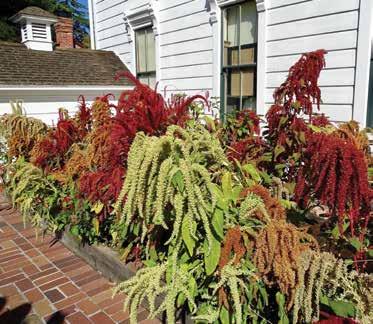
What’s a summer without pole beans? Amaranth
Keep Mint Going
When mint starts setting flowers in late spring or early summer, leaf growth slows down and all of a sudden there are no nice, new fresh leaves for the tea. Keep mint plants leafy as long as possible by continuously pinching off the tips of the stems, even if you don’t use the leaves. The continual pinching keeps the plant making new stems. I like mint blooms because they support small pollinators and predator insects, so I normally keep three large pots of mint in the garden so that one blooms while the others are continually harvested. Once the weather gets hot, mint does better in the shade and with plenty of moisture; a pot lets you move it to a cooler spot.

Spiderwort, A Prolific Blue Native
Spiderwort is one of those plants that you have to put in the right place because it likes to reseed and spread. However, in a wild open space where you can just mow

it down when it turns ugly, it’s a great filler. Native to our state, it offers a blue color that most gardeners love, and blooms in midspring, often bridging the gap between the early and late spring flowers. Some selections are pink or white, but blue is the most popular. The plant stays in bloom for at least a month, then makes seed heads that will cause seedlings to spread. After setting seeds, the upright plant will flop over and turn yellow, a sign that it is time to cut it back. Plants do best in moist soil with partial shade, but this is such a tough plant that it will reseed in less than ideal locations.
Pour and Repeat
The sound of splashing water is a nice touch in a garden, especially when it’s cleverly designed. This simple fountain came from the Garden Home of P. Allen Smith in Roland, Arkansas. As you can see, the water circulates from the tub up to the watering can and then drops back down into the tub from the rose on the can. All this is done with pipe, tubing and a recirculating pump to power the water up to the can which is mounted on a pipe. It makes a nice splash and a good sound as the water hits the tub. It is best placed in a shaded area to help reduce evaporation.

Spiderwort is a tough, prolific wildflower.
Pinch mint back regularly to keep it producing.
Gardeners have great imaginations.





PLANT
• If you haven’t already, plant warm-season Bonnie vegetables such as tomatoes, peppers, eggplant and squash.
• Tomatoes, potatoes, peppers and eggplant are members of the nightshade family. They like similar growing conditions, but should not be planted adjacent to or in succession from year to year because they all are susceptible to the same diseases.
• Plant sweet potato slips.
• Apartment dwellers with a patio getting at least six hours of sun a day can easily grow peppers in containers.
• Gourds may be planted in May.
• Lift and divide overcrowded clumps of daffodils and other spring-flowering bulbs.
• May is a good time to divide herbaceous perennials you want to propagate or that are getting too big. Dividing will also help the plant to produce new growth.
• Plant container-grown trees and shrubs. Stop planting bare-root trees and shrubs.
• Early spring annuals such as pansies and calendulas will soon fade with summer’s heat.
• Clean out the beds and plant summer-flowering annuals.
FERTILIZE
• Apply a high-nitrogen, summer lawn fertilizer to encourage a healthy-looking lawn.
• Work lime into the soil around your old-fashioned hydrangeas to produce pink flowers or aluminum sulphate for blue.
• Fertilize azaleas, rhododendrons and camellias after they bloom with a fertilizer made for acid-loving plants.
• Annuals planted recently should be fed on a monthly basis throughout the spring and summer.
• Fertilize bulbs after blooming.
• Lightly side dress perennials with an all-purpose, 5-10-10 or 10-10-10 fertilizer. Avoid spilling the fertilizer on the plant, and use care not to damage the shallow roots when you cultivate it into the soil.


• Fertilize warm-season grasses such as St. Augustine, zoysia, Bermuda and centipede. Stop fertilizing cool-season grasses such as fescue and bluegrass to prevent heat damage.


PRUNE
• Deadhead! It consumes the plant's energy to produce seed. In many species of plants, especially annual plants, removing the dead flowers will promote further blooms.
• Promptly remove spent flowers from any plant unless your intent is to harvest the seeds. It consumes the plant’s energy to produce the seeds and, in many species of plants (especially annuals), removing the dead flowers will promote further blooms.
• Remove any reverted green shoots on variegated (leaves with two colors) evergreens to prevent them reverting to a single color.
• Take softwood cuttings of deciduous shrubs such as forsythia and hydrangea.
• Prune spring-flowering trees and shrubs soon after they bloom. Since they begin setting next year’s flower buds in late summer, it’s important to have them pruned and fertilized before then.
WATER
• Collect rainwater in a rain barrel for irrigation.
• Use a soaker hose where possible to avoid getting vegetable foliage wet.
• Hand water new transplants until they become established.
• Water your lawn in the morning to discourage fungus diseases.
• Mulching around the base of your plants will help them to retain moisture around the roots.
PEST CONTROL
• Address insect, disease and weed problems as soon as you spot them.
• Labels provide directions on how to mix, apply, store and dispose of a pesticide product.
• Slugs and snails are out in full force right now. Be sure to take steps to control them immediately, before they have a chance to reproduce and devastate your garden.
• Continue to watch for thrips, red spider mite, caterpillars, white fly, leaf rollers and scale.
• Be on the lookout for lace bugs and aphids this month.
• Examine conifers for the egg sacs of bagworms and remove before the eggs hatch.
• Keep a vigilant eye on the roses. Continue to spray for black spot and mildew control. Also keep them sprayed for aphids and other pests.
• Hoe regularly between rows on hot days to make sure the weeds dry up and die.
• This is the time to eliminate lawn weeds by hand pulling, or the application of a “weed and feed” fertilizer ... before they go to seed!
ODD JOBS
• Keep up with the vegetable harvest to encourage your plants to continue producing.
• If you haven’t already, put your houseplants outdoors on a shady porch so they can enjoy the summer heat while protected from strong sun and wind. You can also bury potted houseplants up to the rim in planting beds to add texture.
• Check to see if your houseplants are root bound. Water them thoroughly and carefully remove them from their pots. If the roots have compacted around the outside of the root ball, it is time to repot.
• Clean pond filters.
• For maximum flavor, don’t let zucchini get more than 8 inches long.
• Give your clay and plastic pots a boost on sunny patios. Elevate pots onto boards to lessen the damaging effects on plants from heat radiated off the hot concrete.
• Put supports in place now for tall herbaceous plants or those with heavy blooms before they are too tall.
• The compost pile should be getting a lot of use these days, both in utilizing this prime garden resource and adding fresh garden refuse to it. The compost pile should be kept damp.
• Frequent turning will turn your garden waste into plant food much faster.
• Work rain-compacted soil around plants and flower beds to provide aeration. Use shallow cultivation to prevent root damage.
• Remember, birds are still nesting. Keep the feeder full!
SIMPLE TIMES
BY SUZY M c CRAY

Simply Music
When I was a little girl, Trenton and Marjorie Stewart operated a dairy just up the road from the little white-frame church where our family were members.
In the 1950s, it was common in rural Alabama to have revival services each morning as well as night services for a week or two each summer. I can clearly remember how Trenton would make sure the milking and other chores were worked around those two revival services each day so he, his family and his hired hands and their families could all attend church.
The Stewarts were chosen as the county’s Young Farm Family of the Year way back then and they just exemplified how important religious beliefs, as well as church attendance, was back then before the internet, all sorts of ways to watch TV and lifestyles filled with extracurricular activities began to take up more and more of our time.
But along with that church attendance, something else was included in most every family. More family homes had pianos than didn’t. And usually at least one
child, maybe more, took piano lessons to learn to play.
I can remember in that tiny church when the old upright piano was replaced with a shiny new console when I was just a toddler. I can remember Mrs. Nell Bynum’s beautiful hands with sparking rings playing those ivory keys while her husband Paul “led” the singing. It seemed like every little girl in that church (and more than a few young men) aspired to be just like Mrs. Nell.
The Bynums’ daughter Cathy was just a year older than me. When we weren’t arguing who was better, Roy Rogers or Gene Autry, Cathy and I were vying for a turn on that piano’s waxed seat, but Sandra Nugent had us all beat. Being about four years older than us and thus more proficient at tickling those ivories. The competition was real!
For a couple of summers, Mr. Eugene Whitt came and conducted old-fashioned singing schools. While I sounded like a cross between a squeaky frog and a weak kitten when I sang, I looked forward to each night because Mr. Whitt let all of us girls have a turn at the
piano! By this time I was about 11 years old and we were singing the old Stamps Baxter type gospel songs.
Mr. Whitt was a stickler for the pianist following the leader, no matter what the written music said. Even though he had written many of the songs we were singing, he would raise his hand directly to instigate untimely stops in the oddest places, just to make sure the pianist and the singers were paying attention.
I was a somewhat shy child. It seemed every night I’d cry all the way home because accompanying Mr. Whitt was so nerve-wracking. But every night I was dressed in my little pastel starched dress and ready to go back way before time to leave.
(Years later when I was majoring in music in college, my teachers and instructors always were amazed at my ability to follow the leader when I was accompanying the choir or other groups of singers! I would just smile silently and say a little prayer of thanks to precious Mr. Whitt!)
But many things have changed in this world. There are many churches who have wonderful music nowadays. Some even with orchestras and other things we wouldn’t have dared dream about when attending those little rural churches where air conditioning was never heard of and the bathrooms were still “out back.”
Last year, my husband and I found ourselves looking for a new-to-us church to attend, after his being an elder in his former church for more than 35 years. We still live in a fairly rural area and we were looking for a smaller-type church.
One thing that really surprised us was the music. In many churches we visited, there were several gifted pianists who either took turns or played for various areas of worship such as one accompanying the congregation singing and another playing for the choir. Many had organs or keyboards as well as grand pianos.
But in several churches we visited, there was literally no one to play the piano, and some of them were fairly large churches for our area. Most used CDs of the hymns and everybody sang along. The song leader had to sing at whatever pace the pianist on the CD played. I was shocked that there were so many without musicians. How things had changed in the past 60 years!
Where once you could simply “borrow” a teenager from a nearby church if your church found itself without a musician for whatever reason, now you just popped in a CD because those teens either couldn’t play or wouldn’t play or there simply wasn’t enough of them to go around.
So many schools now don’t have music teachers because music is low on the priority list when finances are delegated. Many schools have good band programs, but often children don’t get in them until middle school or later.

Maybe I’m just a little old-fashioned, but in my simple life I miss singing quartet-style songs around a piano in the living room, or sitting on the porch on a Saturday night singing and listening while someone’s grandpa played the guitar and an uncle fiddled away. Maybe somebody’s grandma even showed out a little picking the banjo, and what are our children MISSING by not pumping those carpeted pedals on those gorgeous old pump organs?
Nothing can top the memory of taking a mason jar of cool water to your daddy and hearing a gospel song in the distance long before you caught up with him with your bare feet squishing through the dusty clods….
It’s marvelous to listen to the world of music through the marvel of all sorts of electronic devices, but nothing can replace the simple joy of little fingers stumbling as they play their first hymn in church or the wavering sound of an old song sung from the memories of a weary but contented heart.
“Let the word of Christ dwell within you, with all wisdom teaching and admonishing one another with psalms and hymns and spiritual songs, singing with thankfulness in your hearts to God.” (Colossians 3:16)
(Suzy and her husband Mack strive to live a simple life on a small homestead in Blount County. She can be reached through their Facebook page or at suzy.mccray@yahoo.com)
Gone are the days of singing quartet style songs around a piano in the living room.
BY TONY GLOVER

It’s Earth Berry Time Again
In my hometown of Cullman, the early German settlers called strawberries “erdbeeren,” or, more literally translated, they were called earth berries. German settler Andrew Kessler may have brought the first strawberry plants to Cullman in 1880. In 1886, during a picnic to commemorate the founding of Cullman, John Cullmann toasted the recent discovery of coal, the exploration for oil and the hoped-for arrival of an east-west railroad, along with the success of local ventures in wine, strawberry and cotton production. The success with wine was short-lived due to a disease problem that still makes it difficult to grow
most European wine grapes in Alabama. However, both cotton and strawberry production took off in a big way. Cullman County became a leader in both commodities. The Georgia farmers who moved to the area favored cotton, but the German farmers favored fruits and berries.
By 1936, Cullman was harvesting 2,200 acres of strawberries and had become the strawberry-producing capital of Alabama if not the entire South. My grandfather once told me that not everyone in Cullman grew strawberries but everyone picked them. He recollected that the schools let the children out for
strawberry and cotton picking times. I recently read a history of Cullman agriculture that documented that before the United States entered the Second World War, Cullman farmers were literally shipping thousands of barrels of strawberries to England to help feed their hungry population.
During the strawberry “heyday,” Cullman held a very large annual strawberry festival that brought folks from all over North Alabama to celebrate the harvest season each spring. After World War II, acreage began to fall as other opportunities for returning soldiers multiplied and the strawberry festival was ended. Thankfully, several years ago, local officials decided to resurrect the Cullman Strawberry Festival and even though we will likely never have the large acreages we once grew, we do have several local producers who grow strawberries for local sales.
This year’s festival will take place May 2 and will be held at the Festhalle Market Platz-Farmers Market in downtown Cullman near the railroad line that once shipped thousands of crates of berries to Chicago and beyond. The festival plays host to many activities including a wonderful assortment of local artisans selling their wares at an arts and crafts event in Depot Park across from the farmers market.
If you are close enough for a drive to Cullman, come enjoy the festival and take home some sweet local berries. If you live too far away to visit Cullman, just look around and find some local strawberries in your area before the season passes you by. You may visit this website to find area farms and markets: http://www. fma.alabama.gov. To get more details about the Cullman Strawberry Festival, visit their Facebook page at www.facebook.com/CullmanStrawberryfest.

Cullman farmers (1960s) Carlis and Eurene Clemmons (deceased)






BY JOHN HOWLE
May Motivation

“You shall eat the fruit of the labor of your hands; you shall be blessed, and it shall be well with you.”
- Psalm 128-2
May means hay, hard work and warm, lengthening days. It means caring for the livestock and the garden. May means mosquitoes and flies, but it also means fishing in farm ponds, camping and outdoor adventures. May is a great month to find joy in your work and get motivated to work and play in the outdoors.
Fly Control
With warm weather come flies and the threats they pose to cattle. Horn and face flies are the top two enemies of cattle. The horn fly spends just about its entire life feeding on cattle. The face fly feeds on fluids from the eyes but will also feed on any wounds of the cattle. Face and horn flies breed in fresh cow manure in pastures, and this is why regular grazing rotations are important to help break the fly life cycle.
HOW’S YOUR GARDEN SIMPLE TIMES THE CO-OP PANTRY HOWLE’S HINTS

These horn flies can be controlled with a back rub, face flyps, and fly bullets charged with permethrin-based insecticides.
Chemical-impregnated ear tags, pinkeye vaccinations, and regular wormings will help reduce fly problems in your herd, but you can also use the natural movements of the cattle to control flies by using a back rub with face flyps and fly bullets. Dr. Pierce White, DVM, owns the company popular for its fly control products, and you can visit them online at www.phwhite.com.
I’ve used many products to control flies, but Dr. White’s method seems to be the most consistently effective. Simply tie the face flyps onto the 10-foot back rub, connect a couple of fly bullets at each end, and suspend the back rub between posts at a gate or barn entrance. You can place your mineral tub where cattle have to go through the back rub to get salt.
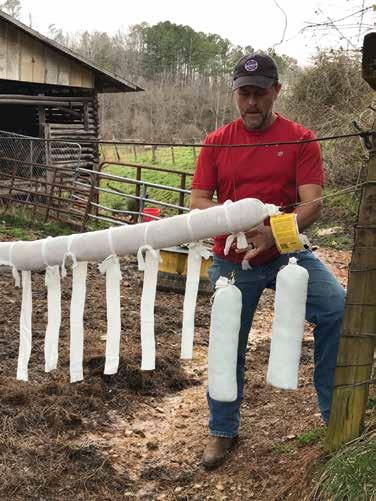
Charge the rub with a mixture of diesel and permethrin-based fly control or you can also use mineral oil. Any oil works well when mixed with the permethrin, and the oil helps the mixture stay on the cattle longer. There is even a handy mixing chart on the company’s website www.phwhite.com that gives you precise mixing instructions to control flies on your cattle. All of the P.H. White products are made in the USA and can be purchased from your local Co-op.
These 10-foot back rubs can be charged by using a 2-gallon hand sprayer, but I’ve learned that a used syrup tub makes a great charging container. I simply coil the back rub up into the tub, and pour the insecticide and oil mixture into the tub. The back rub absorbs just about all the chemicals while in the tub. You do have to use extra caution when putting the back rub back in place
because it has oil all over it. This method is, however, much quicker than charging the back rub with a sprayer.
Avoid Tetanus
Tetanus is a serious, sometimes fatal, disease of the central nervous system that is caused by an infection of a wound with spores of the bacterium, Clostridium tetani. These spores live in the soil, so greater risks of getting the disease while taking part in outdoor activities are apparent. A fish hook in the hand, getting a foot cut on broken glass, or any puncture wound that appears contaminated deserves close attention. To avoid the dreaded disease with symptoms such as lockjaw and severe muscle spasms, get a tetanus vaccine. For minor injuries, get a tetanus shot if your last one was over 10 years ago. For serious puncture or contaminated wounds, get a tetanus shot if your last one was over five years ago. Your local health department or doctor can administer the shot and give you more information.
Dislodge the Lodge
Beavers can cut down or girdle trees as well as ruin corn, soybeans and other crops that they either eat or use for dam construction materials. They can also
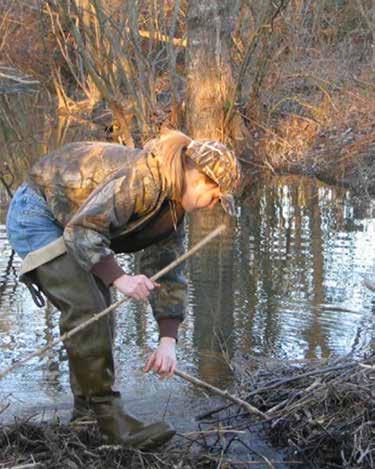
Tear a hole in the beaver dam to get a shot at beaver when they come back to repair.
A back rub with face flyps and fly bullets controls flies. Simply recharge the rub with insecticide and oil or diesel every couple of weeks through the fly season.
do great damage to hunting and fishing areas. When control is necessary, one way to get a shot at these rodents is to tear a hole out of the dam. You might get a shot when the beavers return to repair the damage. Check with your local game officials to see if beaver are protected in your area, and get the necessary permits before you start a control program.
May Garden
As you get your garden ready, don’t forget to pick up fertilizer at your local Co-op. A common choice for gardens is 13-13-13. These numbers mean that there is 13% nitrogen, 13% phosphorous, and 13 pounds of potassium per 100 pounds of fertilizer. The remaining pounds in the bag are filler to use as a medium for spreading.
Nitrogen helps plants grow green and grow fast. Phosphorous is good for cell division, root formation, and flowering and fruit growth. Potassium helps with photosynthesis and a shortage results in stunted growth and yellow lower leaves. Plants such as corn require higher amounts of nitrogen for proper growth and ear formation.
With corn, for instance, you can lay off or plow your rows. Then, distribute the 13-13-13 in the rows and plow through once. Plant your corn seeds. Once the corn is around six inches tall, you can add ammonium nitrate around the growing plants and cover it with a garden


tool. The nitrogen rating for ammonium nitrate is 34-00, which means there is 34 pounds of nitrogen per 100 pounds of fertilizer. Your local Co-op can get the right fertilizer mix for your garden this May.
This May, get out and enjoy both the work and the recreation.

Your local Co-op will provide you with the right fertilizer for your garden this May.
Garden corn such as Silver Queen requires quite a bit of nitrogen.
Food Preservation Season is Just Around the Corner
Gardeners throughout time have relished the fruits of their labor. Kneeling in dirt and picking through weeds is well worth a bite of your own luscious ruby red tomato or crispy cucumber. So why enjoy the splendor of your garden for only a few months out of every year? Preserving is a great way to get the home gardener through the winter months until next year’s planting. Not only is it rewarding to open a jar of your own home-grown produce but the economical and nutritional benefits are obvious.
The art of preserving food has existed since the beginning of civilization and has been vital to survival all throughout history. Every culture has utilized one or

more methods to maintain fresh food. Often the methods used were dictated by the climate and conditions in which people lived. Foods were preserved in times of abundance to prepare for the desperately lean times that would surely lie ahead. As a result, many innovative techniques and advancements in food preservation were made during these extremely lean times. While we may not face the harsh living conditions of our forefathers, we have inherited from them a desire for fresh, wholesome food. It’s no coincidence, however, that we may be facing some tough economic times and to save money on food dollars the lost art of preserving is being rediscovered.
Not only can preserving foods yourself save money, it can be incredibly rewarding to place food on the table which you have grown and preserved yourself. Or better yet, to share with friends and family. And knowing exactly what goes in – or more importantly – what is not going into our preserved goods gives an added measure of control.
HOW TO PRESERVE
How does preserving work?
Fresh food is perishable for several reasons. Because of its high water content, an increased growth of undesirable microorganisms, an increased activity of food enzymes, increased reactions with oxygen, and adverse effects from moisture loss, all result in the breakdown and spoilage of food. The process of preserving slows down or stops the activity of microorganisms and enzymes and keeps food fresh and safe to consume.
Each method of preserving comes with its own set of benefits. Dabble in the different types – canning, drying, freezing, pickling, salting or fermenting – to discover which suits and works best for you. Equipment for preserving food can range from simple and cost almost nothing, all the way to complex and cost as much as you’re willing to spend. However, pressure canners and water-bath canners will probably only need to be purchased one time or may even be inherited from our mothers or grandmothers. They will last for years if taken care of properly. Make sure you visit your local County Extension Office to get your dial gauge pressure canner checked once a year for accuracy. If your dial gauge is off two pounds or more it can be a danger to the safety of your home-canned vegetables and meats. Safety is essential when undergoing any preserving endeavor. Preserving methods have strict guidelines that must be followed and require that you follow instructions exactly or dangerous results can occur. Check with your local County Extension Office for recipes or look for recipes online from the National Home Food Preservation website which is operated by the University of Georgia Extension Service. It is very important to follow USDA-tested recipes because a deadly bacteria called “botulism” can be lurking in your unopened pressure-canned vegetables and/or meats if not canned properly.
Always choose food of the highest quality when preserving. Pick food that is free of bruises, discoloration and defects. Preserve as quickly as possible after
harvesting - preferably within 12 hours. Wash and scrub food thoroughly before processing and always maintain proper sanitation to prevent the spread of bacteria.
Canning is not the only way to preserve the freshness of homegrown vegetables. Freezing is another great economical and easy way to preserve. Look for an article next month on freezing.
When storing preserved foods, be sure to clearly label the foods you have preserved both with contents and date preserved. Preserved food will not last forever. It is important to know when your products’ shelf life has expired and when foods should be discarded; you can find this out from your local County Extension Office. Labeling also helps to keep current when rotating your preserved food supply.
If you would like to learn more about preserving your own foods at home, whether you grow your own or you purchase from a local farmers market, visit our website at www.aces.edu/foodsafety/ and see if there is a class being offered near you, or if you just have questions contact your local County Extension Office or Angela Treadaway the Food Safety & Quality Regional Agent at treadas@aces.edu or at 205-410-3696.
THE HERB LADY

Spanish Moss
Montrose is a lovely area on Mobile Bay. This very old “community” was established long ago. Before a fourlane route was built, Montrose was on the main route from Spanish Fort to Fairhope. Today it is considered “The Scenic Route.” I often travel this route. In so doing, I’m traveling under a canopy of old live oaks, many of which are adorned with Spanish moss.
On a recent trip through the area, I took special notice of the well-maintained natural growth. Some of the growth that caught my eye was yellow dock, smilax, goldenrod, broom sage, wild scuppernongs (I call these “bullaces”), ragweed and others.
Many stories to be told there, but this story is about Spanish moss. This truly Southern plant drapes from many trees like icicles on a Christmas tree. It seems to be partial to some host trees. It does no harm to the tree. Since this plant grows in Pike County, I have seen it all my life and enjoyed its beauty. When people visit in its growing area, they are usually curious about the unusual plant. A young relative of my husband who lives in a northern state once made a trip to the south. He later called and asked, “What was that pretty gray stuff which is hanging from so many trees?”
Spanish moss must have proper humidity to exist. Once on a tour I was told that it grows no further north than Wetumpka, Alabama. According to the graph provided by North American Wildlife (a Readers Digest publication) it grows a good bit farther north and inland to the Mississippi river.
It is interesting to see a tree in a wooded area which is literally covered with moss. That one tree is covered and others are completely bare of the moss. Moss seems to pick its host tree. It does no harm to the host tree since it has no roots. It gains all nutrients as well as moisture from the atmosphere. Dust is a good example.
There was a time when Spanish moss was gathered for use as stuffing in automobiles. (I think my Uncle Dallas’ old Model A Ford’s seats were stuffed with moss.) Also, it was used for furniture and mattresses. Sometimes today it is still used as packing or stuffing. I have seen it used as mulch in flower beds.
Today its primary use is for crafts and flower arrangements. If you are ever in the area, take the scenic route through the lovely area called Montrose.
While moss is using trees as a host, red bugs (chiggers) are using Spanish moss as a host. As a country child of the Depression era, I am very familiar with these tiny pests. When berry picking, etc., I would become covered with the little imps. Following a good Octagon soap bath, Mother would touch each itchy, red welt with kerosene. This would kill the red bug and heal its sting. The treatment never hurt me, but today it would be considered a big NO-NO. Before electricity was available to homes, kerosene was always on hand for lamp lights. That’s a thing of the past also.
Once I met a lady who told me she placed Spanish moss in a bottle of rubbing alcohol for a very good liniment.
The Herb Lady
Nadine Johnson


FROM PASTOR TO PASTURE

Sounding the AlarmAgain
Every chance that I have, I try to cook a good breakfast for Jack, Darrell, and myself before we start our work for the day. Occasionally another guest or two will join us. It is good, at our age, to have time to just sit, eat, drink some good coffee, and enjoy one another’s company before we have to get up and get busy. At some point in our conversations, we usually bring up the fact that we used to talk about the “old men” who once did what we are now doing!
There is another event that has become a common occurrence that will happen at some point early on during our gatherings. It usually happens just after the bacon and sausage are done and when I am heating up the grease to fry the eggs. Without fail, our lady friend on the wall will begin her routine: “Fire, fire! Warning!
Warning! Fire, fire!” She will continue this routine, getting louder and louder each time, until Darrell gets up and fans the fire alarm with his paper plate. This happens so often that now, we do not even acknowledge it. Darrell just gets up and fans the alarm without missing a beat in what he is saying.
We have heard the warning so many times that it does not even bother us much anymore. At first, we at least looked to see if a paper towel or something had caught on fire, which sometimes happens, but now we just ignore the warning and do whatever is needed to silence the alarm.
I remember other alarms when I was growing up during the Cold War that were harder to ignore. I remember the symbol, the distinctive tone, and the message
of the Emergency Broadcasting System that would break in on the programming on our black-and-white television set: “This is a test. This station is conducting a test of the Emergency Broadcasting System. This is only a test.” The unmistakable alarm signal would sound for 20-25 seconds followed by: “This is a test of the Emergency Broadcast System. The broadcasters of your area in voluntary cooperation with the Federal Communications Commission and other Federal, State and local authorities, have developed this system to keep you informed in the event of an emergency. If this had been an actual emergency, the Attention Signal you just heard would have been followed by official information, news or instructions. This concludes the test of the Emergency Broadcast System.”
The Emergency Broadcast System was established to provide the president of the United States with an expeditious method of communicating with the American public in the event of war, threat of war or grave national crisis. Through the EBS, the president would have access to thousands of broadcast stations, cable systems and participating satellite programmers to transmit an emergency message to the public.
Today, the EBS is mostly used to warn of severe weather or other natural disasters, but it is still in place in case of a national threat. The system has expanded to local siren alarms that sound off if tornadoes or other severe weather systems are detected. There is no
telling how many lives have been saved in recent years because these emergency alarms sounded just in time to provide sufficient opportunity for people in the path of tornadoes to hear the alarm and take the necessary actions that saved their lives.
I also remember a time when another alarm was being sounded that warned of a coming event promised in the Bible that is much more important than severe weather, disease, or even nuclear attacks on our country: the return of Lord Jesus Christ to judge the world. Yet, for the most part, those who are supposed to be sounding the alarm that Jesus is coming back, this time as a judge, are either absent or silent; perhaps out of fear, or maybe because they have been deceived into believing that the coming judgment will not be as bad as has been promised. It could be they are either ignorant of, or indifferent to the Word of God and the consequences for the people who are not prepared for the coming disaster. At best, the warnings of the few who are still sounding the alarm are going unheeded and the faithful few are being criticized and rejected because people do not want to hear or believe the truth. Hearers do not want to accept or believe that they are sinners deserving of death and eternal punishment. They want to live life by their rules, doing what they want to do, without any fear of potential consequences.
When the Japanese attacked Pearl Harbor it caught everyone by surprise. No one thought it could





really happen. While the bombers were in the air, everyone on the ground was going about life as usual, feeling secure in their ignorance of the coming attack. When the Twin Towers fell in 2001, nobody thought we could be caught by surprise like that again, but we were! If anyone had sounded an alarm warning of the coming attacks, we would have at least had the opportunity to be prepared and take protective measures. Our ignorance of the coming attacks did not save lives – it cost lives!
When Jesus comes back, and He will, most people will not be ready. The Bible tells us so. It is not our responsibility or even within our power as Christians to save people from the coming judgment. It is, however, our responsibility and within our power to love them enough that we would sound the alarm, warning them of the coming judgment and showing them how they can be ready to meet Him and face the judgment with their sins forgiven. It is our responsibility to prepare them for the coming judgment by leading them to the One who gave His life as a ransom for theirs so that He could intercede for them at the judgment. It is our responsibility both to know and to teach the standards and conditions contained in God’s Word.
will stand before Him and give an account for where we stand in our relationship with Him and what we did in this life. What we do with Jesus will determine where we spend eternity: in Heaven or in Hell! He gives us the freedom to chose to turn from our sin, follow Him and inherit eternal life or to reject/neglect Him, live in our sin and be condemned.
This is not a test! Judgment is coming! Your sin will not go unpunished if it is unforgiven. It cannot be forgiven unless it is forsaken, and your faith is placed in Jesus. He is the only One who can forgive and deliver you and me. This is an actual emergency warning! You are instructed to call out to Jesus to save you, to turn from your sin and follow Him.
If anyone had sounded an alarm warning of the coming attacks, we would have at least had the opportunity to be prepared and take protective measures. Our ignorance of the coming attacks did not save lives – it cost lives!
Sin is the reason for the coming judgment, and we are all guilty. God, the Creator of all that is, is a holy and righteous God who cannot and will not let sin go unpunished. John 3:16 tells us that we are all sinners, BUT, because of God’s great love for us, He sent His only son Jesus to die in our place for our sin, making it possible for us to be forgiven. Jesus then conquered death when He was resurrected from the dead, giving the opportunity for everyone to have eternal life. However, He does not force His salvation on anyone nor is our salvation unconditional.
People reject Jesus and His teachings because they see that their lives do not line up with His teachings or His character. They see His standards as too strict and offensive because it conflicts with how they want to live. They blame Jesus and those who follow them for their guilt, but John 3:17 tells us that Jesus did not come to condemn the world, but to save the world; the world is condemned already because we are all sinners. We do not have to change anything to go to hell. Jesus, out of love, came to save us and deliver us from our sin and God’s wrath toward sin.
Jesus will one day judge the world. Every one of us
EVERY person, in ALL the world, will be FOREVER affected by the coming judgment! No one will be exempt or immune! For those who are not prepared, the consequences could not be more severe or devastating. Who is sounding the alarm? Where is the fear? Where is the concern for the eternal safety and eternal life of others? Where is the government’s concern and willingness to save their masses from the coming judgment that will have eternal, everlasting effects on each and every individual? Governments, businesses, industries and institutions of education are taking unprecedented measures to protect their customers, employees and students from threats whose real effect is unknown at this point. At the same time, the same institutions are prohibiting even a discussion about the world’s need to be reconciled to a Holy God, through the Good News of Jesus Christ.
Jesus is coming back! When He does, He will judge the world! Be ready. Tell others. He could return today!

TWO










» Long-Lasting Results Kills and prevents grasses and weeds for up to ONE YEAR!
» Use Only Where No Vegetation Is Desired Avoid the root zones of plants you wish to keep








THE CO-OP PANTRY
BY MARY DELPH
May is National Barbecue Month—a time to salute and celebrate delicious BBQ! This month, we are going to look at luscious BBQ recipes and all their fixings.
- Mary
Sweet Cola Ribs
For the sauce
1 Tablespoon vegetable oil
1 medium onion, finely chopped
3 cloves garlic, finely chopped
2 cups ketchup
1 can cola
1/2 cup apple cider vinegar
2 Tablespoons brown sugar
1/2 Tablespoon freshly ground black pepper
1/2 Tablespoon onion powder
1/2 Tablespoon ground mustard
1/2 Tablespoon lemon juice
1 Tablespoon Worcestershire sauce
In a medium saucepan, over medium heat, add oil. Once heated, add the onion and garlic and sauté until tender. Add all the remaining sauce ingredients and bring to a boil. Reduce heat to a simmer and cook uncovered, stirring frequently, for 1 hour 15 minutes.

For the dry rub
2 Tablespoons salt
2 Tablespoons brown sugar
2 teaspoons garlic powder
2 teaspoons onion powder
1 teaspoon ground cumin
1 teaspoon chili powder
1 teaspoon black pepper
Whisk all dry ingredients together in a small bowl. This can be stored up to six months in an airtight container.
For the ribs
2 racks pork spareribs (about 3 pounds each)
Rinse and dry ribs. Place on a clean cutting board, pull off the membrane and trim the ribs of excess fat. Liberally season both sides of the ribs with rub. Wrap ribs with plastic wrap and refrigerate 4 to 12 hours so flavors can permeate. Preheat grill to 250 degrees using hickory and charcoal. Set up your grill for indirect heat. Place ribs, meatier side down, on the grill away from the coals. Close grill cover. Cook the pork ribs for one hour and 15 minutes, flipping several times for even cooking. Coat ribs with sweet cola barbecue sauce and cook for another 20 minutes.
Note: Save some sauce for dipping when the ribs are served.
Baked Beans With Bacon
10 slices bacon, diced
2 Tablespoons bacon fat or butter
1 yellow onion, finely diced
1/2 green bell pepper, finely diced
54-ounce can pork and beans or equivalent number of smaller cans
4 Tablespoons ketchup
1/4 cup molasses
2/3 cup brown sugar
1/4 cup cider vinegar
2 teaspoons dry mustard

Cook bacon about half way through (in whichever way you want), and set aside to drain on a paper towel. Preheat oven to 325 degrees and set rack to the lower-middle rack position. In a deep skillet, heat about two tablespoons of bacon grease (or butter) over medium heat. Add diced onion and green pepper and sauté about five minutes, until softened. Add remaining ingredients and stir to combine well. Let mixture simmer for a minute or so. While the mixture is simmering, grease a 13x9 baking dish. Pour beans into the prepared baking dish and lay cooked bacon on top of the beans. Bake for 2-3 hours, depending on your desired consistency. Let the beans stand for five minutes before serving.
Southern Coleslaw
Slaw
1 pound green cabbage (about half a medium cabbage)
1 large carrot, peeled
1/2 small white onion
Dressing
1 Tablespoon distilled vinegar
1/2 cup mayonnaise
1 Tablespoon white sugar

1/4 teaspoon coarse kosher salt
1/4 teaspoon ground black pepper
1/2 teaspoon celery seeds (not celery salt)
Chop or grate the cabbage, carrot and onion as you wish and set aside.
Whisk together the dressing in a large bowl. Add the cabbage, carrot and onion. Taste, adjust seasonings and cover. Chill for at least one hour if possible before serving.
Barbecued Burgers
Sauce
1 cup ketchup
1/2 cup packed brown sugar
1/3 cup sugar
1/4 cup honey
1/4 cup molasses
2 teaspoons prepared mustard
1-1/2 teaspoons Worcestershire sauce
1/4 teaspoon salt
1/4 teaspoon liquid smoke
1/8 teaspoon pepper
Burgers
1 large egg, lightly beaten
1/3 cup quick-cooking oats
1/4 teaspoon onion salt
1/4 teaspoon garlic salt
1/4 teaspoon pepper
1/8 teaspoon salt
1-1/2 pounds ground beef
6 hamburger buns, split
Toppings of your choice
In a small saucepan, combine the first 10 ingredients. Bring to a boil. Remove from heat. Set aside one cup barbecue sauce to serve with burgers. In a large bowl, combine the egg, oats, 1/4 cup of the remaining barbecue sauce, onion salt, garlic salt, pepper and salt. Crumble beef over mixture and mix well. Shape into six patties. Grill, covered, over medium heat for 6-8 minutes on each side or until a thermometer reads 160°, basting with 1/2 cup barbecue sauce during the last five minutes. Serve on buns with toppings of your choice and the reserved barbe-


STRAWBERRYFEST
May 2, 2020
Cullman - Festhalle Market Platz Call 256-734-9157
FLIMP FESTIVAL
May 2, 2020
Montgomery - Montgomery Museum of Fine Arts & Blount Cultural Park
10:00 a.m. - 2:00 p.m. Call 334-240-4333
YATTA ABBA DAY
May 2, 2020
Abbeville - Downtown
9:00 a.m. - 3:00 p.m. Call 334-585-2273
MAYFEST
DAIKIN FESTIVAL
May 1, 2020
Decatur - Point Mallard Park
6:00 - 10:00 p.m.
Call 800-524-6181
GULF COAST HOT AIR BALLOON FESTIVAL
May 1-2, 2020
Foley - Foley Sports Park Call 251-943-3291
WHISTLESTOP FESTIVAL & ROCKET CITY BBQ COOK-OFF
May 1-2, 2020
Huntsville - Huntsville Depot
Friday: 4:00 - 11:00 p.m.
Saturday: 10:00 a.m. - 11:00 p.m.
Call 256-426-2350
SOUTHERN MARKET DAYS "FRESHLY PICKED" VINTAGE MARKET
May 1-2, 2020
Hartselle - Sparkman Civic Center
Call 256-773-2581
SPRING PLANTIN’
May 1-2, 2020
Troy - Pioneer Museum of Alabama
Admission - 9:00 a.m. - 4:00 p.m.
Call 334-566-3597
ANNUAL FLOWER SPECTACULAR
May 1-31, 2020
Wetumpka - Jasmine Hills Garden and Outdoor Museum - Admission
Friday and Saturday: 9:00 a.m.5:00 p.m.
Sunday: Noon - 5:00 p.m.
Call 334-328-8917
ART ON THE ROCKS
May 2-3, 2020
Gadsden - Noccalula Falls Call 256-549-4663
RECALL LAGRANGE
May 2-3, 2020
Leighton - 1461 LaGrange College Road Call 256-446-9324
MAYFEST
May 8-9, 2020
Guin - 7500 U.S. Hwy 43 Friday: 5:00 - 10:00 p.m. Saturday: 8:00 a.m. - 4:00 p.m. Call 205-468-2242
PRATTVILLE CITYFEST
May 2, 2020
Atmore - Tom Byrne Park
9:00 a.m. - 4:00 p.m. Call 251-368-3305
KYMULGA GRITS FESTIVAL
May 2, 2020
Childersburg - Kymulga Grist Mill & Covered Bridge 9:00 a.m. - 4:00 p.m. Call 256-378-7436
CHILDREN'S FESTIVAL IN THE PARK
May 2, 2020
Enterprise - Enterprise Recreational Complex - 2:00 p.m. Call 334-347-1211
WILDFLOWER SATURDAY
May 2, 2020
Fort Payne - DeSoto State Park Call 256-845-0051
GARDEN IN THE PARK
May 2, 2020
Opelika - Opelika Municipal Park Call 334-240-4333
CITY FEST
May 2, 2020
Trussville - The Mall Downtown
Admission Call 205-655-7535
71ST ANNUAL BLESSING OF THE FLEET
May 2-3, 2020
Bayou La Batre - St. Margaret’s Catholic Church 10:00 a.m - 4:00 p.m.
Call 251-824-2415
May 8-9, 2020
Prattville - Main Street
Admission Friday: 7:00 - 11:00 p.m. Saturday: 9:00 a.m. - 5:00 p.m. Call 334-365-7392
BIRMINGHAM ROSE SHOW
May 8-10, 2020
Birmingham - Birmingham Botanical Gardens - 1:00 - 4:00 p.m. Call 205-585-9687
HOMESTEAD HOLLOW ARTS AND CRAFTS FESTIVAL
May 8-10, 2020
Springville - Various Locations
Admission 9:00 a.m. - 5:00 p.m. Call 205-467-2002
DRAGON BOAT RACE & FESTIVAL
May 8-10, 2020
Decatur - Point Mallard Park Aquatic Center - Kick Off: 8:30 a.m.
Racing: 9:00 a.m. Call 256-350-2028
PLANTS AND POLLINATORS FESTIVAL
May 8-10, 2020
Millbrook - Alabama Nature Center NaturePlex - 9:00 a.m. - 5:00 p.m. Call 334-285-4550
ALABAMA WILDLIFE CENTER'S BABY BIRD SHOWER
May 8-10, 2020
Pelham - Alabama Wildlife Center 11:00 a.m. - 2:00 p.m. Call 205-663-7930



CHUNNENUGGEE FAIR
May 8-10, 2020
Union Springs - Downtown
9:00 a.m. - 3:00 p.m.
Call 334-738-8683
ART IN THE PARK
May 9-10, 2020
Foley - John B. Foley Park
9:00 a.m. - 5:00 p.m.
Call 251-943-4381

FRONT PORCH STORYTELLING FESTIVAL
May 14-16, 2020
Florence - The Shoals Theatre
Admission - 10:00 a.m. - 10:00 p.m. Call 256-764-1700
U.S. 11 ANTIQUE ALLEY YARD SALE
May 14-17, 2020
Fort Payne - U.S. Hwy 11 through Alabama - 10:00 a.m. - 8:00 p.m. Call 256-845-3957
POKE SALAT FESTIVAL
May 15-16, 2020
Arab - Downtown Friday: 2:00 - 9:00 p.m.
Saturday: 10:00 a.m. - 8:00 p.m. Call 256-586-3138
LIMESTONE COUNTY SHERIFF’S RODEO
May 15-16, 2020
Athens - Sheriff’s Rodeo Arena Gates open: 6:00 p.m. Rodeo: 8:00 p.m. Call 256-232-0111
ORANGE BEACH BILLFISH CLASSIC
May 15-16, 2020
Orange Beach - The Wharf Marina Admission
Friday: 7:00 - 10:00 p.m.
Saturday: 6:00 - 10:00 p.m. Call 251-224-1000
BARBER HISTORICS
May 15-17, 2020
Leeds - Barber Motorsports Park & Museum - Admission Call 205-298-9040
THE HANGOUT MUSIC FESTIVAL
May 15-17, 2020
Gulf Shores - Gulf Shores Beach The Hangout - Admission Call 251-948-3030
LOGAN MARTIN LAKEFEST AND BOAT SHOW
May 15-17, 2020
Pell City - Logan Martin Lake Call 770-826-3524
THE FESTIVAL AT THE WELL
May 16, 2020
Glenwood - Downtown at the Well Admission - 9:00 a.m. - Midnight Call 334-334-3426
ARMED FORCES DAY/BLUE STAR SALUTE CELEBRATION
May 16, 2020
Mobile - USS Alabama Battleship Memorial Park - 6:30 a.m. - 1:00 p.m. Call 251-471-4322
CATFISH FESTIVAL
May 16, 2020
Scottsboro - Jackson County Park
9:00 a.m. - 5:00 p.m. Call 256-574-4305
CAHABA LILY FESTIVAL
May 16, 2020
West Blocton - Cahaba Lily Center Call 205-938-7304
ARTS ALIVE FESTIVAL
May 16-17, 2020
Florence - Wilson Park 9:00 a.m. - 5:00 p.m. Call 256-766-1445
RHODODENDRON FESTIVAL
May 16-17, 2020
Mentone - Mentone Brow Park Saturday: 9:00 a.m. - 5:00 p.m. Sunday: 9:00 a.m. - 4:00 p.m. Call 256-845-3957
COALFEST
May 22-23, 2020
Brilliant Friday night and all day Saturday Call 205-465-2281
ALABAMA JUBILEE HOT AIR
BALLOON FESTIVAL
May 23-24, 2020
Decatur - Point Mallard Park
6:00 a.m. - 10:00 p.m.
Call 800-524-6181
MEMORIAL DAY PROGRAM
May 25, 2020
Montevallo - Alabama National Cemetery - 9:00 a.m. Call 800-524-6181
MEMORIAL DAY AT THE AMERICAN VILLAGE
May 25, 2020
Montevallo - The American Village Admission - 10:00 a.m - 4:00 p.m. Call 205-665-3535
A CELEBRATION OF MEMORIES
June 5, 2020
Thomasville - Alabama Southern Community College 7:30 - 5:00 p.m. Call 334-637-3146
HANK WILLIAMS FESTIVAL
June 5-6, 2020
Georgiana - Hank Williams Boyhood Home & Museum Call 334-376-2396
MULEDAY/CHICKENFEST
June 5-6, 2020
Gordo - Main Street Friday: 6:00 - 11:00 p.m. Saturday: 8:00 a.m. - 2:00 p.m. Call 205-364-7111
9-1-1 FESTIVAL
June 5-6, 2020
Haleyville - Downtown Call 205-486-4611
NORTH ALABAMA AFRICAN HERITAGE FESTIVAL
June 5-6, 2020
Tuscumbia - Willie Green Recreation Park - 11:00 a.m. - 8:00 p.m. Call 256-381-1797
“What’s Happening in Alabama” Policy The AFC Cooperative Farming News publishes event listings as space allows, giving preference to agricultural events of regional or statewide interest and those that are annual or one-time events. The magazine assumes no responsibility for the accuracy of information submitted for publication and advises calling ahead to confirm dates, locations, times and possible admission fees.
To be included in the calendar, send listings to: Cooperative Farming News Calendar of Events P.O. Box 2227 Decatur, AL 35609 -oremail to Calendar of Events at subscribe@alafarm.com
*Please include name of event, where it will be held (both town and physical location), a phone number for more information, and an email or website.*
*Event Listings must be received at least two months in advance and will be accepted up to a year in advance.*
CLAY COUNTY STOCKYARD
1050 Airport Road - Ashland, AL
Sale Every Tuesday at 12:30 p.m.
Tad and Kim Eason, Owners Barn: 256-354-2276 Tad: 397-4428
Hauling available
Check us out on Facebook!
SAND MOUNTAIN STOCKYARD, LLC
19509 AL Hwy 68 - Crossville, AL 256-561-3434
Cattle Auction - Every Wed. & Sat. at 11:30 a.m.
Call for any hauling & catching needs


VALLEY STOCKYARD
13130 AL HWY 157 - Moulton, AL
Cattle Auction - Wed. at 11:00 a.m.
Billy Wallace (C) 256-303-7097
Phone: 256-974-5900 Fax: 256-974-5899 Your Full Service Stockyard
MID STATE STOCKYARDS
8415 State HWY 97 South Letohatchee, AL 36047
Sale Day: Tuesday at 10:00 a.m. 1-877-334-5229 or 334-227-8000 www.midstatestockyards.com
at mcfarlandadvantage@gmail.com

May 1-2 - Clanton, AL
May 22-23 - Opelika, AL
June 5-6 - Oxford, AL
June 12-13 - Alex City, AL
October 30-31 - Coaling, AL




